Field Guide to Creatures of the Dreamlands - S.Petersen's 1989
-
Abhoth
Abhoth is a huge pool of phosphorescent matter, constantly bubbling and putting forth limbs, mouths, and pseudopods. Entire obscene monsters form continuously in that boiling gray mass and then crawl away from the parent. Abhoth’s tendrils and other limbs retrieve many offspring, which are then devoured by the primal mass, but other child-things manage to escape, crawling away into the endless black caverns wherein this monster god exists.
The creatures continually budding from Abhoth’s form render it difficult, even dangerous, to approach. At birth, few of the spawned creatures are larger than a man, and most are much smaller. They grow rapidly. In many areas of the Underworld they make up important parts of the ecosystem.
Abhoth, though considered a deity (the ’Source of Uncleanness’), has no known human worshipers (Wydatem, 1990). Possibly it is worshiped by Gugs or other entities of the Underworld, or even by its own spawn.
Habitat: the depths of the Underworld.
Distribution: Abhoth is manifestly not native to the Dreamlands or Earth. Its intelligence, immobility, and taste for dark caverns imply a relation to Tsathoggua.
Life and Habits: investigators lucky enough to return from an encounter with Abhoth report that, once aware of their presence, the being extrudes a probing hand or member which carefully feels or passes over the intruders, then drops off and crawls away (as do all its created organs). Visitors are then seized and absorbed, ignored, or occasionally interviewed. Abhoth reveals high intelligence in these sporadic communications, though it evinces no ambition to leave or even to move about its shadowy home.
This monstrosity eats nothing but itself and random visitors. The source of the body mass which supports Abhoth’s ongoing fecundity cannot be explained; see Isinwyll (1988) for a summary of researcher conjectures.
Distinguishing Abhoth —
♦ Its continuous production of living organisms from its own body mass differentiates Abhoth from all other beings known in Earth’s Dreamlands.
-11 -
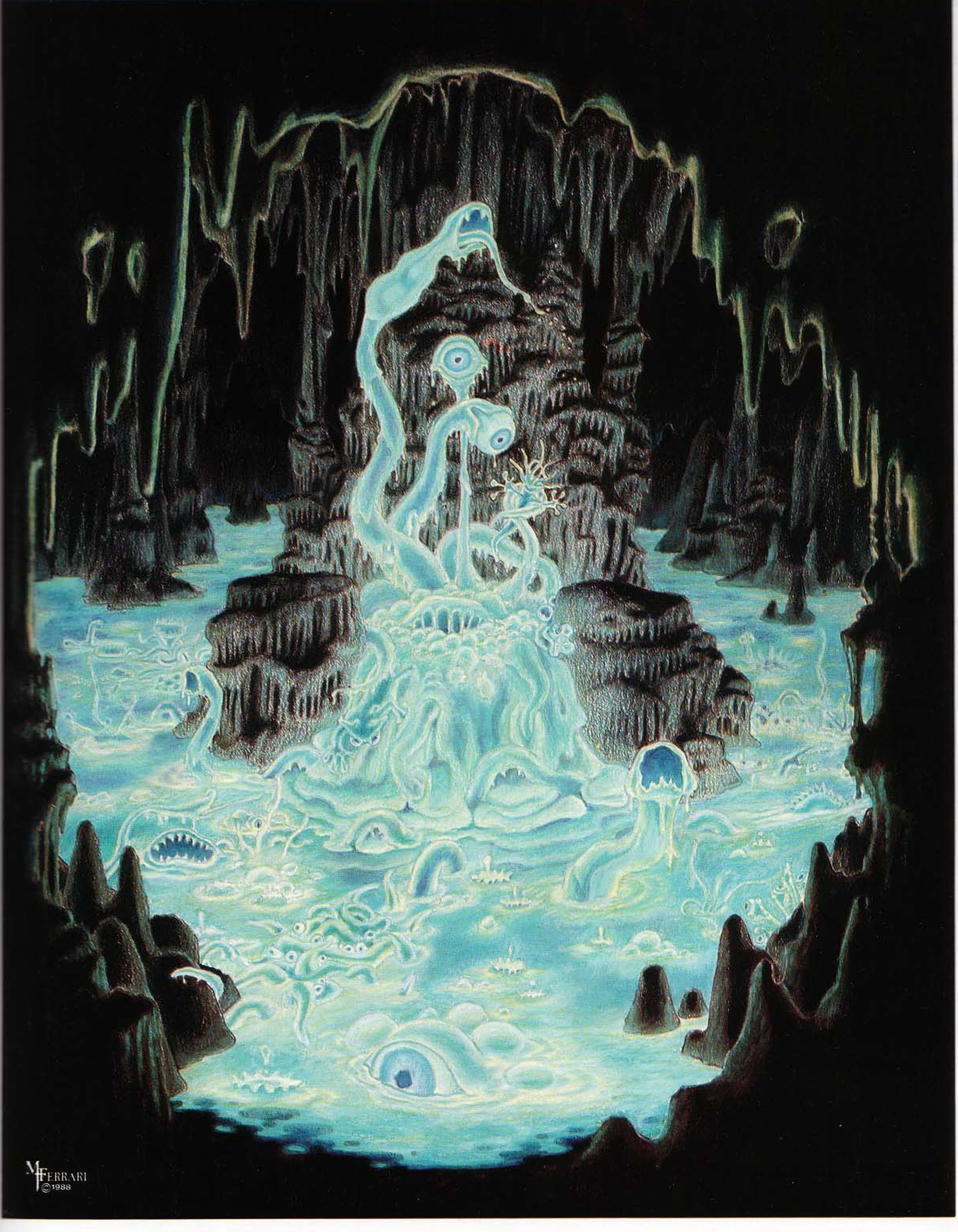
21'
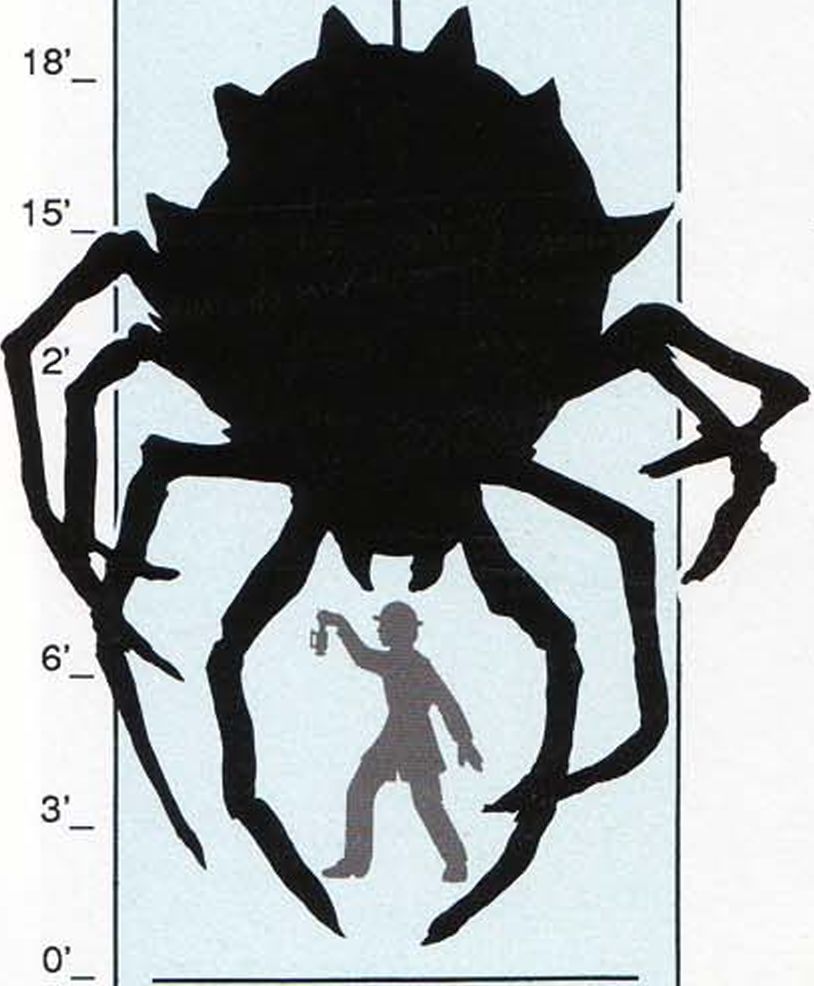
COMPARATIVE SIZE CHART, 3' INTERVAL
Bridging The Chasm
As reconstructed from anonymous reports, Atlach-Nacha’s webs span the bottomless chasm; the bridge as shown is about a quarter of a mile long. Atlach-Nacha is the tiny dot, center-left on the top strand, just before the first angular support from the left meets the top strand. In this version the bridge is far from finished.
“ . . . Out of corruption horrid life springs, and the dull scavengers of earth wax crafty to vex it and swell monstrous to plague it. Great holes secretly are digged where earth’s pores ought to suffice, and things have learnt to walk that ought to crawl.”
— H.P. Lovecraft.
Atlach-Nacha
Atlach-Nacha resembles a large and grotesque spider with a weird, half-human face. It lives underground, eternally spinning its fantastic web, eternally bridging (for unknown reasons) an unguessably deep chasm. Ancient texts suggest that a completed web-bridge heralds the end of the world (Smith, 1934).
Probably through association, superstition holds that this spiderlike being rules all spiders; it has no organized worship among humans. Using hyperdimensional geometry, one can summon away Atlach-Nacha from its task. This can be dangerous, for the spider
god hates to abandon its endless spinning.
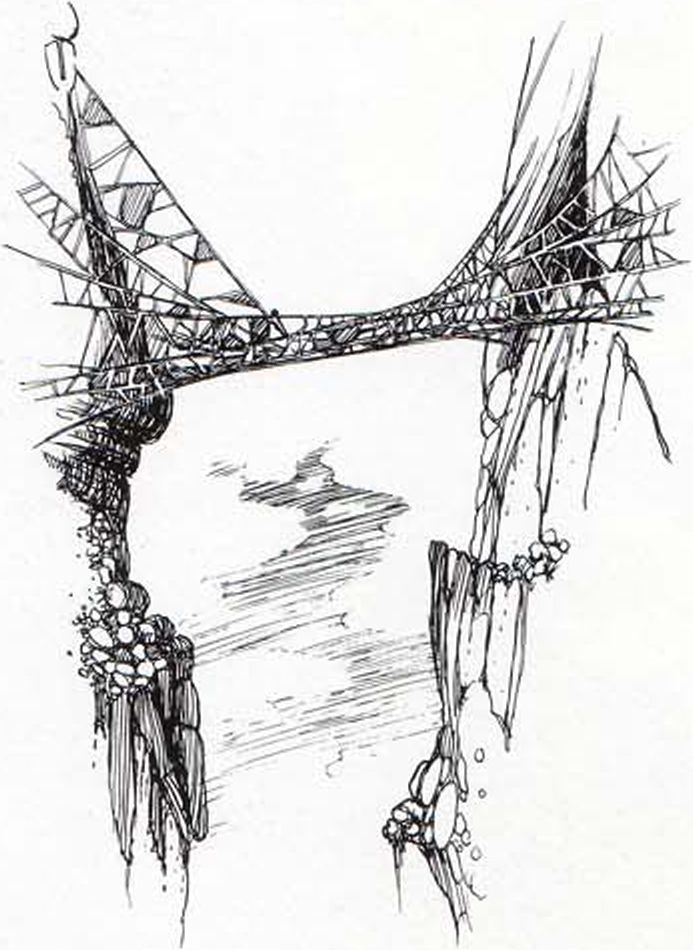
Atlach-Nacha’s origin is unknown. Its anthropomorphic head may show relation to the humanoid Great Ones, or the spider-god may be a powerful human or prehuman sorcerer whose transformation furthers its famous task.
Habitat: underground. Presumably it could dwell elsewhere, but chooses not to do so in order to sustain its spinning.
Distribution: at the bottomless chasm in the Great Abyss, unvisited as yet despite diligent search. The Barton-Doherty expedition, seeking a physical route to this place in the Peruvian Andes, vanished without trace (Dannseys, 1986a).
Life and Habits: Atlach-Nacha works constantly on its web. Reportedly its bridge-like webwork is heavily (though incidentally) used by creatures needing to cross the chasm.
Though a carnivore like other spiders, Atlach-Nacha dislikes leaving its weaving even to feed, and has rejected prey which would be time-consuming to devour. Barton-Doherty expedition members wore laced fiberglass plates, hoping that the job of extricating their bodies from those indigestible shards would prove too lengthy for the spider-god’s patience, prompting chances for interviews.
Atlach-Nacha’s bite injects a paralytic agent which instantly and perfectly inactivates most of the target’s voluntary muscles. Even with professional care, a victim may need six months or more to recover (Smith, 1931a). Miskatonic’s School of Medieval Metaphysics offers a standing reward for a venom sample.
Distinguishing Atlach-Nacha —
♦ Leng Spiders are purple, are frequently found out-of-doors, and do not have half-human faces.
Fig. 2 —Atlach-Nacha's bridge: hypothetical view.
- 13 -

2V.
18'.
15'.
12’.
9’

COMPARATIVE SIZE CHART, 3' INTERVAL
Powerful Poison
Even though a Basilisk’s range may be restricted (in this case between the water and some sheltering hills), the monster’s contamination inexorably works into the local water table and becomes of great consequence, polluting the nearby river for miles downstream.
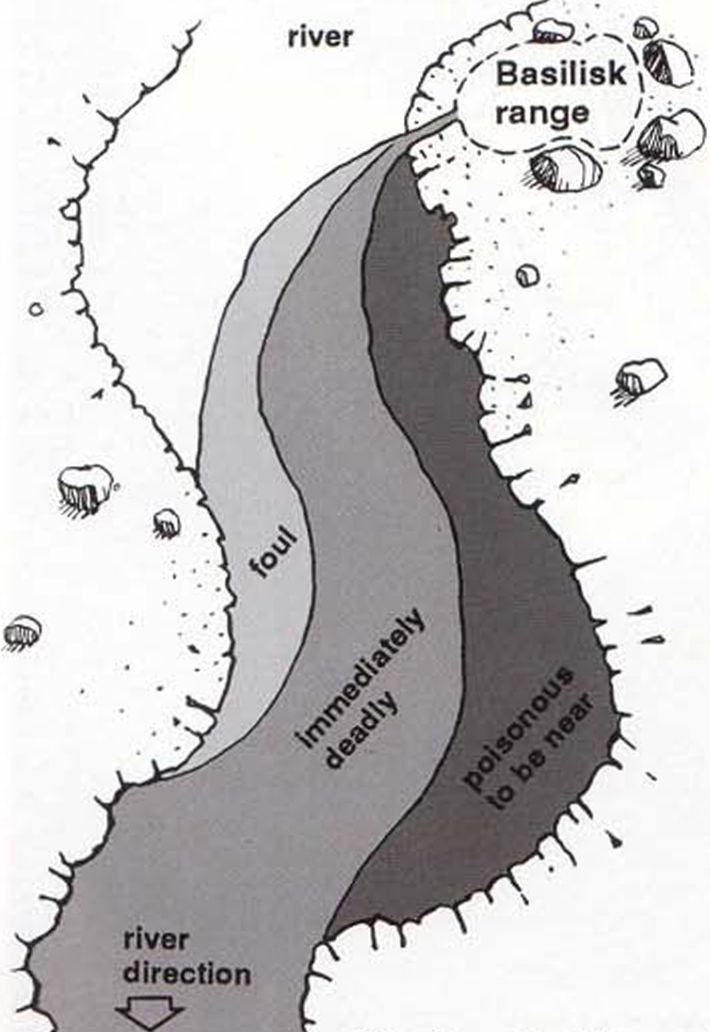
“I have haunted the tombs of the ages, I have flown on the pinions of fear Where the smoke-belching Erebus rages; Where the jokulls loom snow-clad and drear: And in realms where the sun of the desert consumes What it never can cheer.”
— H.P. Lovecraft.
Basilisk
The legendary king of serpentdom, this snake-like organism has an ornate crest, a ribbed scaly body, and an evil fanged face.
The Basilisk is the embodiment of venom. The stream from which the Basilisk quenches its thirst is contaminated and poisoned for many yards downstream. Fumes rising from its lair are deadly to birds flying overhead. A human bitten by a Basilisk dies instantly, features twisted and blackened. No antidote to its venom is known.
Touching either the corpse of an animal bitten by a Basilisk or a Basilisk’s fresh spoor may fatally infect the unwary. Basilisk blood is highly poisonous. Ratsegg (1969) reports a case in which a man on horseback speared a Basilisk. Venom traveled up the spear with lightning speed, splitting and blackening the shaft as it went. The rider was poisoned, dying within two seconds, after which the venom traveled through the saddle and killed the horse on which the spearman sat.
The breath of the monster is also deadly, and may kill anyone approaching too closely. This organism can even kill with its glance. By staring fixedly at a victim for at least 1.4 seconds, it projects a deleterious enzyme into the victim’s metabolism. Meeb (1986) correlated 287 cases of Basilisk death-by-glance and discovered that 202 of the victims died within two seconds.
Only trained pretematuralists should deal with Basilisks.
Habitat: desolate wilderness - even lush lands become blasted and barren after a Basilisk arrives.
Distribution: anywhere.
Life and Habits: eats carrion and everything poisonous. Nux vomica plant beans (the source of strychnine) are avidly devoured by this organism, which also prizes scorpion stingers, adder heads, and toadskins.
We know nothing of Basilisk reproduction. Possibly this solitary creature is not a true animal, but a preternatural construct. The Cockatrice, for instance, similar to the Basilisk in many ways, is sexless and normally must be specially created.
Distinguishing Basilisks —
♦ Butterfly-Dragons are partially insectoid, and have no feathers; ♦ Serpent People are wingless.
Fig. 3 — Basilisk contamination.
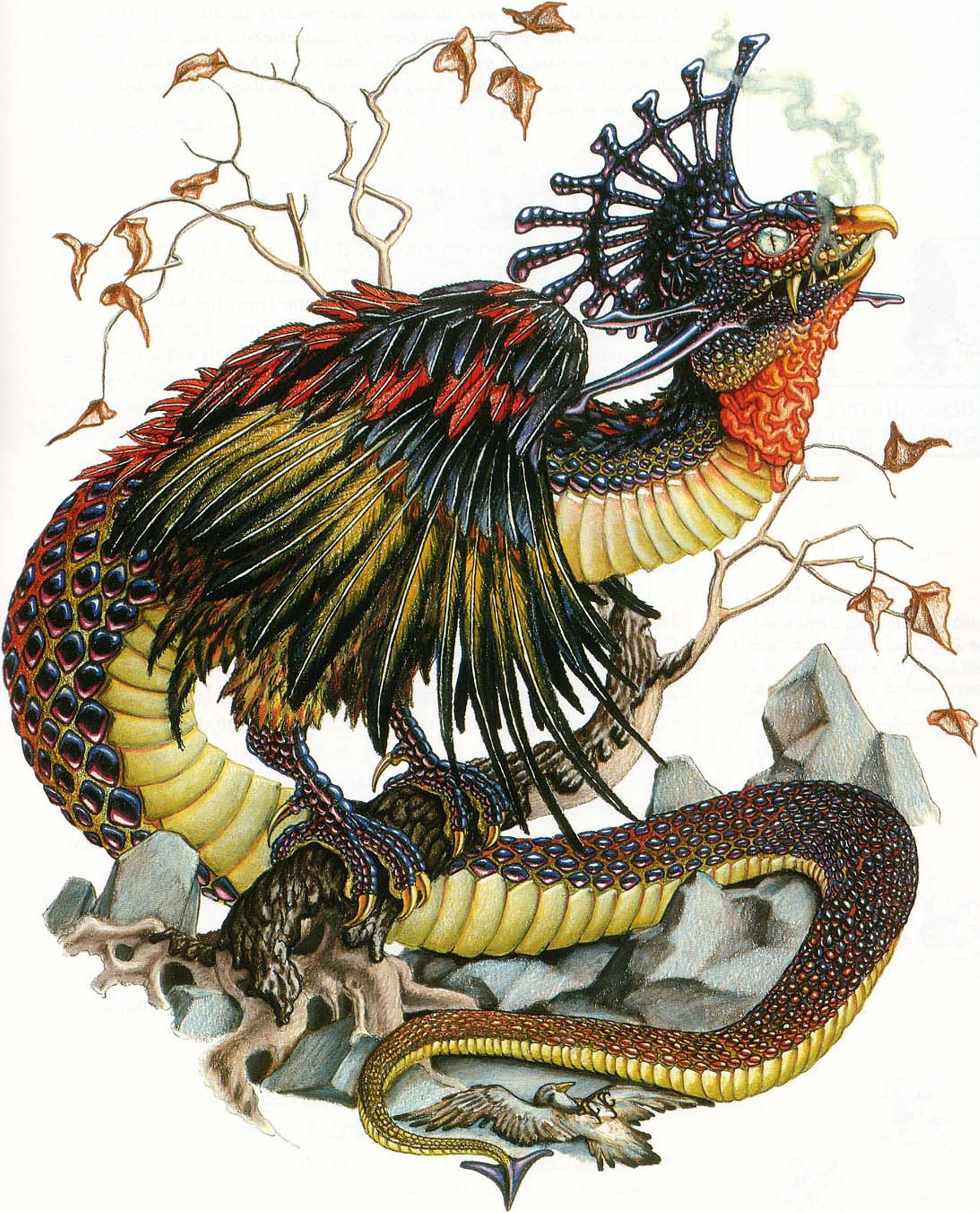
TERRARI ©1988
21
18'_
15’_
12’_
9’_
6’_
3'_
0’
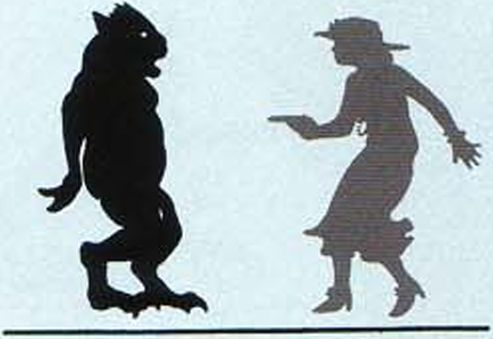
COMPARATIVE SIZE CHART, 3’ INTERVAL
Telltale Sign
Though Samath-area Beings oflb are long-dead, their ghosts may not know it. Many continue as though normally alive, and even leave footprints.

“Very odd and ugly were these beings, as indeed are most beings of a world yet inchoate and rudely fashioned. It is written on the brick cylinders of Kadatheron that the beings of lb were in hue as green as the lake and the mists that rise above it; that they had bulging eyes, pouting, flabby lips, and curious ears, and were without voice.”
— H.P. Lovecraft.
Being Of lb
In prehistoric times, the Beings of lb descended from the sky in a mist, along with a gray stone city (lb) and a vast lake. The men of Sarnath, who believed them to have come from the Moon, exterminated the Ibites millennia ago, but more of the race presumably exist on the Moon or elsewhere. Their solid-seeming ghosts still wander the ruins of lb and and the site of Sarnath.
Isinwyll (1989) may have met representatives of this species in the western Dreamlands, near the Bnazie Desert.
A Being of lb is humanoid, but more variable in size than humans. A typical adult Ibite weighs around 90 kilograms (200 pounds) and stands just under two meters tall (about six feet). But specimens from 40 to 180 kilograms weight and 1.4 to 2.4 meters height are not uncommon.
An Ibite is without voice or any means of vocalizing sound. How or if one communicates with another remains unknown. Gillman (1982) writes that every Ibite appears to have had identical brain-cell structures, and that such parallelism permitted each Ibite to know what any other Ibite would think or do. He hypothesizes that Ibites do not need to communicate elaborate data.
Habitat: Marshes and lakeshores. No Ibite or Ibite ghost has been reported near salt water, arguing for restricted oviparous reproduction.
Distribution: Possibly extinct in the Dreamlands, or of localized or highly restricted range.
Life and Habits: The Ibites did not know of fire until after arriving in the Dreamlands - perhaps their previous environment lacked oxygen. Those near Sarnath apparently fed on the fish and other inhabitants of their lake, which was filled with life. They devotedly worshiped Bokrug the water-lizard, and danced before that deity’s image whenever the Moon was gibbous.
Distinguishing Beings of lb —
-
♦ Gnorri have no hinder legs, and sport bristly beards;
-
♦ Gugs are much, much larger, and are hairy;
-
♦ Men of Leng have hair and horns, and many, when dressed properly, can pass for human;
-
♦ Serpent People have long tails and scaly hides.
Fig. 4 — Man of Leng: bipedal, digitigrade, central phalange dominant.
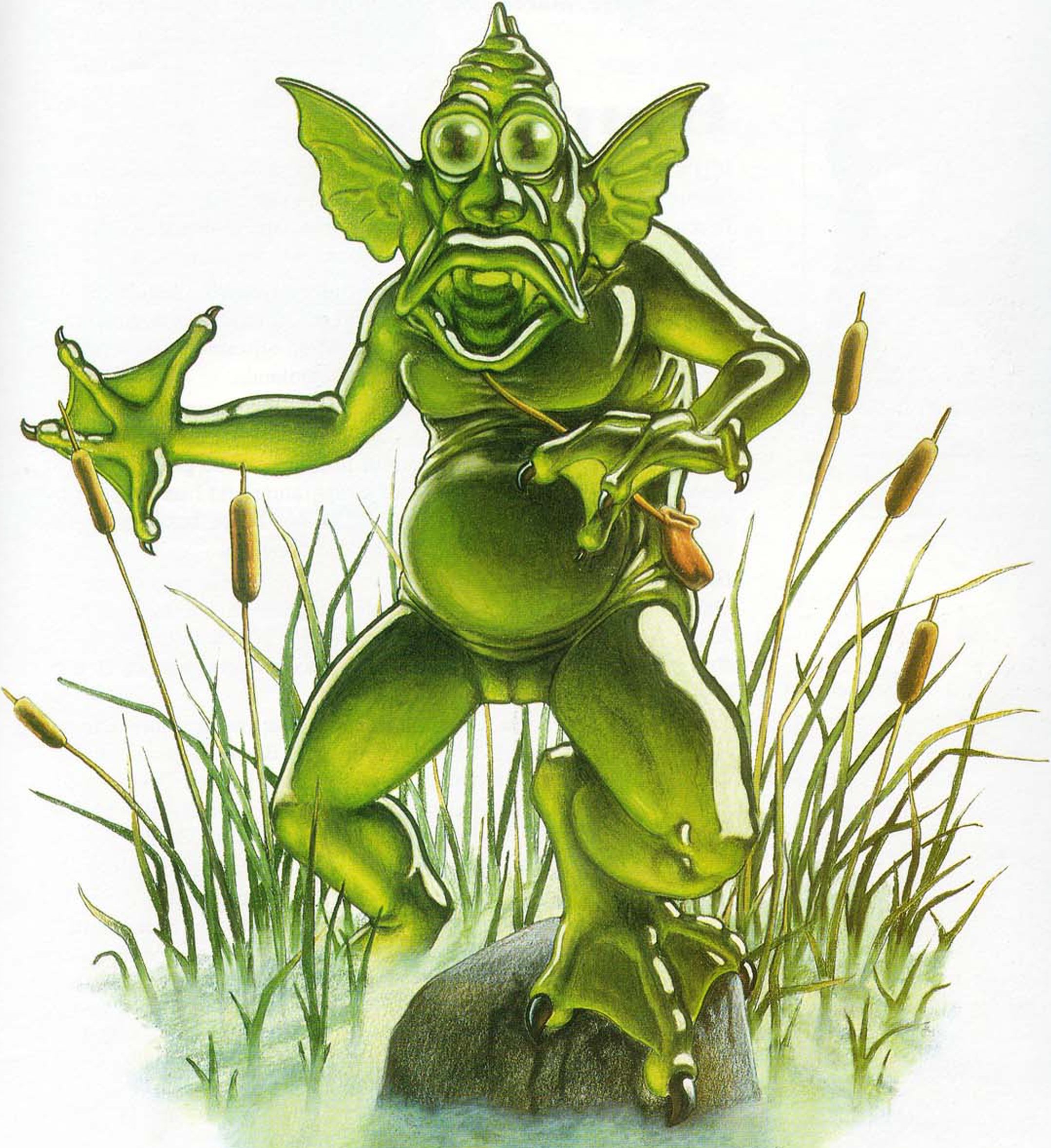
10.5'_
9'_
7.5’_
6'_
4.5’_
3’_
1.5’_
0’

COMPARATIVE SIZE CHART, 1.5’ INTERVAL
Blupe Tragedy
Fig. 5a — Fire inexorably draws the Blupe.

“. . . Whole worlds of matter, energy, and life . . . lie close at hand yet can never be detected with the senses we have .... Such strange, inaccessible worlds exist at our very elbows.”
— H.P. Lovecraft.
Blupe
It is a small semi-transparent entity, elliptical in shape, which floats through the air. A Blupe has a clear, clean odor, like that after a fierce storm. Its translucent internal organs are visible through its skin. In the dark, it glows with a crystalline sheen.
Habitat: The Blupe is not found naturally anywhere outside the Dark Dimension, an opaline plane where light radiates as blackness, and shadows have wavelengths. Controlled obsession now brings Blupes to Earth as it long has to the Dreamlands.
The Blupe prefers moist surroundings. Once summoned to Earth or Earth’s Dreamlands, it slowly dehydrates, rarely surviving for more than 10-15 days. Its useful lifetime can be greatly prolonged by careful regulation of temperature and humidity, or by keeping it underwater (Dannseys, 1988). No Blupe has been successfully bred away from the Dark Dimension.
Distribution: this animal is found in the Cire Enicar area of the
Dark Dimension (Webber coordinates W.2880, X.84604, Y.375, Z.9678) and in the liquescences surrounding it. There the atmosphere is almost pure water vapor; researchers must carry air supplies.
Life and Habits: neither feeding nor breeding in our plane, Blupes are little-known, though friendly to us. The Blupe is an effective guard against heat- or electricity-metabolizing beings: contact with a
Blupe fatally disrupts entities such as Minions Of Karakal and Fire
Vampires, and even can injure Fthagguans and Fireworms.
Because of its benign nature, the ease with which it can be summoned, and its enhancement of personal security, the Blupe is a favorite of human hard metaphysicians. Current ignorance about Blupe physiology and behavior is absurd, considering the ubiquity of these creatures. We heartily recommend the study of these unimpressive but irreplaceable entities to young researchers looking to establish solid careers.
Distinguishing Blupes —
-
♦ Cldudbeasts are immensely larger, of indefinite shape, are not transparent, and do not glow in the dark;
-
♦ Larvae of the Outer Gods are larger, of infinite shapes, and dwell in outer space;
-
♦ Lamp-efts have glowing eyes and definite limbs.
Fig. 5b — In quenching the torch, the Blupe extinguishes itself.

21
18’_
15’_
12’_
9'_
6’_
3’_
0’

COMPARATIVE SIZE CHART, 3' INTERVAL
“. . . Where once had dwelt fifty millions of men now crawled only the detestable green water-lizard. Not even the mines of precious metal remained, for DOOM had come to Sarnath. But half buried in the rushes was spied a curious green idol of stone; an exceedingly ancient idol coated with seaweed and chiselled in the likeness of Bokrug the great water-lizard. That idol, enshrined in the high temple at Ilarnek, was subsequently worshipped beneath the gibbous moon throughout the land of Mnar.”
— H.P. Lovecraft.
Bokrug
Bokrug is a large, greenish-blue, lizard-like creature. Its scales are metallic in texture, and its eyes glow bright chartreuse. Its lower jaw boasts feelers rather than a dewlap, and it has needle-sharp spines along its back fin. Its feet are webbed, and its tail flattened for swimming. Bokrug is one of the Great Old Ones, supernormal beings of paramount power. Unlike most of those wide-ranging entities, Bokrug focuses nearly the entirety of its attention upon the Dreamlands continuum.
Monolith Mystery Stone bas-reliefs similar to those on this column are found in and around lb. Though the inscriptions remain untranslated, legends make clear that these monuments are sacred to Bokrug, and that special magics allowed the stone of which they are made to be manipulated or moved in unknown ways.

Bokrug apparently came there at the same time as the Beings from lb. Certainly the Ibites worshiped Bokrug from the start. At one time only the Ibites worshiped Bokrug. Currently this entity receives propitiatory worship by the folk of Ilarnek, who correctly credit it with the destruction of ancient Sarnath. Seemingly this worship has pacified Bokrug: no subsequent acts of supernatural destruction are credited to this deity.
Habitat: Bokrug bears the epithet water-lizard. Its holy sites are always near lakes, marshes, or the ocean shore. In ancient times, its temples were associated only with fresh water.
Distribution: Unknown, but evidently confined to the Dreamlands. Bokrug rarely physically manifests itself.
Life and Habits: as Great Old Ones go, Bokrug is benign, reacting only against those who attempt to harm it or its worshipful multitudes, and acting slowly even then. Of reptilian pace, this entity’s wrath may not descend for centuries, and then is thrust upon hapless descendants of the long-dead offenders. Though laggard and misdirected, nonetheless Bokrug’s anger is cataclysmic. The city of Sarnath was once hub of the mightiest Dreamlands civilization. Bokrug destroyed it overnight, so utterly that not even ruins remain.
Distinguishing Bokrug —
-
♦ Butterfly-Dragons are winged;
-
♦ Serpent People stand erect and are smaller;
-
♦ Haemophores are much smaller and often seen.

’^Ferrari J©1988
21
18'_
15’_
12’_
9’_
6’_
3’_
O'_
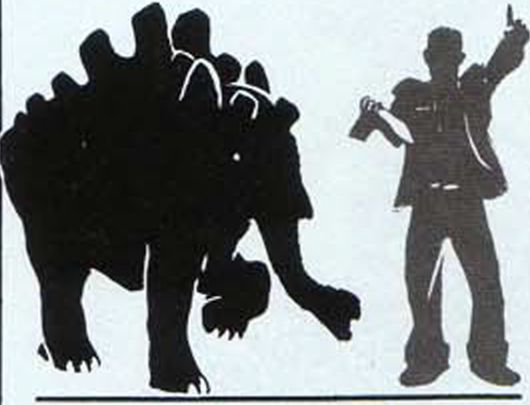
COMPARATIVE SIZE CHART, 3’ INTERVAL
A Primitive Snouter
New evidence suggests that colonies of this ancient creature, the forerunner of the Buopoth, still exist along the road to Mhor.

. As children we listen and dream [and] we think but half-formed thoughts, and when as men we try to remember, we are dulled and prosaic with the poison of life. But some of us awake in the night with strange phantasms of enchanted hills and gardens . . .
— H.P. Lovecraft.
Buopoth
This lumbering herbivorous mammal is reminiscent of the Proboscidea. The Buopoth’s felt-like hide is delicately-colored. The ears are complex and curiously humanoid. The back is adorned with two rows of skin-covered protuberances which seem defensive in purpose. Its eyes are large and disconcertingly intelligent, and its call is a soft trumpeting.
The characteristic Buopoth feature is the proboscis, found among no other living mammal. The musculature and nervation of this unique organ recently have been described (Mustoll, 1988). It is now clear that Buopoths, far from being near-kin of elephants and sirenians, are most closely related to the Rhinogradentia. The ancestor of the Buopoth would appear to have been the so-called Primitive Snouter, a tiny shrew-like mammal (Stumpke, 1964). Habitat: warm tropical forests, avoiding humans and human dwellings.
Distribution: across the central Dreamlands.
Life and Habits: the shy and solitary Buopoth is normally difficult to study, but the musical vigor of its courtship and mating is often reproduced in Dreamlands song and dance. Normally a single calf is born; occasionally twins or triplets are seen. A calf reaches fertile adulthood in three to four years.
A cornered Buopoth may make a single charge, to knock down the threat and to escape. (Since an adult weighs a ton or more and can bolt at speeds of twenty miles an hour, we advise caution.) The fugitive Buopoth may then hide in a jungle thicket for hours. Given a choice, the creature prefers to defend itself by submerging beneath the surface of a stream or lake, taking air through its proboscis, and placidly feeding on underwater plants as it waits for danger to depart.
The tofflebol, a white waxy root sweet and crunchy to the taste, is a favorite delicacy of the Buopoth. The tofflebol bush has sheaves of long, yellow- and green-speckled leaves: a freshly-uprooted bush is good evidence that a Buopoth is in the area (Marik, 1987).
Distinguishing Buopoths —
♦ the distinctive Buopoth renders identification trivial.
Fig. 7 — Side view, Primitive Snouter (Mustoll version).
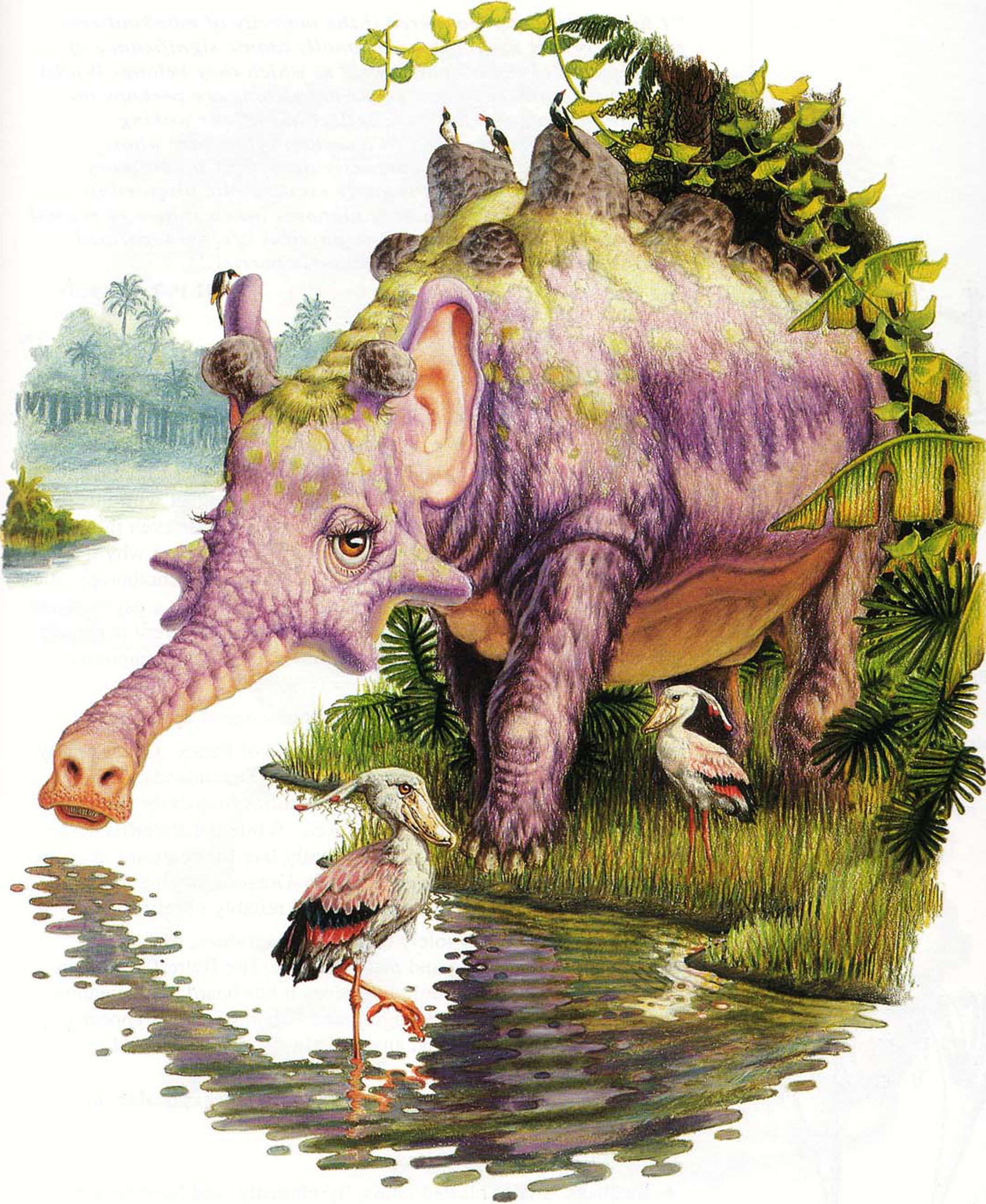
21
18’_
15'_
12’_
9'_
6’_
3’_
O’
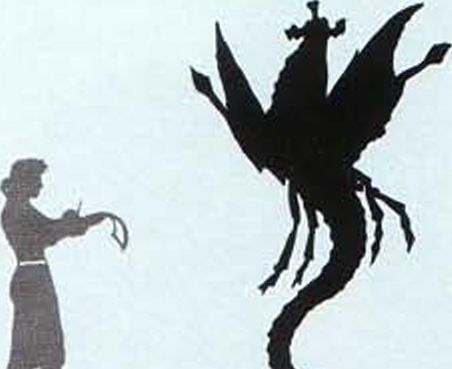

COMPARATIVE SIZE CHART, 3’ INTERVAL
Favorite Snack
Butterfly-Dragons particularly enjoy nectar from the tripleblossomed honeycup. This plant’s copious secretions drip onto passersby and often attract clouds of insects, an excellent reproduction strategy for the plant.
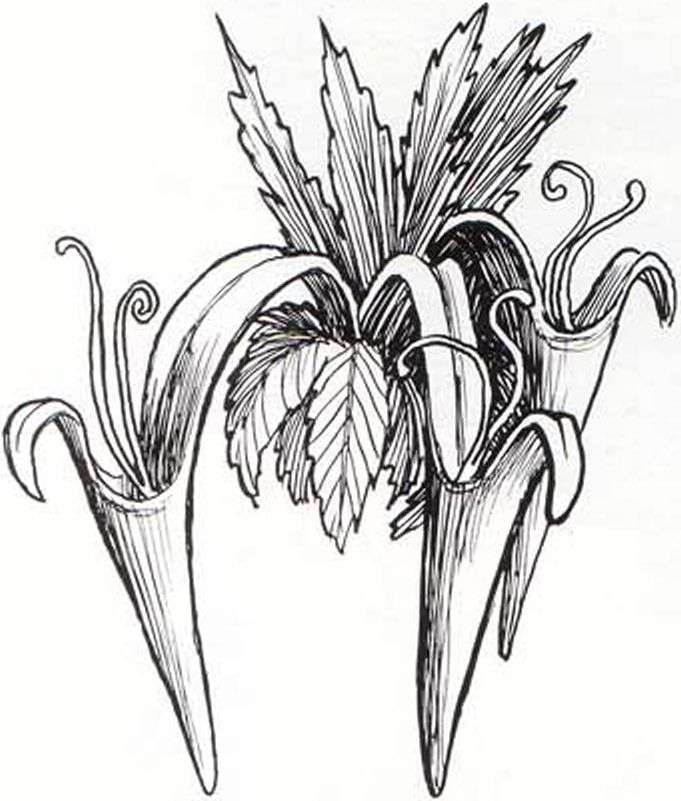
Fig. 8 — Honeycup blossoms and foliage.
“I have frequently wondered if the majority of mankind ever pause to reflect upon the occasionally titanic significance of dreams, and of the obscure world to which they belong. Whilst the greater number of our nocturnal visions are perhaps no more than faint and fantastic reflections of our waking experiences . . . there are still a certain remainder whose immundane and ethereal character permits of no ordinary interpretation, and whose vaguely exciting and disquieting effect suggests possible minute glimpses into a sphere of mental existence no less important than physical life, yet separated from that life by an all but impassable barrier.”
— H.P. Lovecraft.
Butterfly-Dragon
The Butterfly-Dragon is an insectoid creature with beautifully-patterned wings, jointed legs, and a long curved neck and tail.
When threatened, this animal emits a rose-colored mist from spiracles along its body wall. Within seconds, contact with this mist causes a deafness which can pursue a target dreamer even into the waking world. How the creature imposes the effect and why it finds hearing loss an adequate attack remains unclear. Psychotherapy alleviates the hearing loss if it persists, suggesting in turn a psychogenic cause. That could explain why the mist prompts different perceptual effects - dizziness, numbness, loss of taste and smell, temporary blindness - for a few days each year (Choirs, 1972).
Habitat: gardens, meadows, wherever the scene is appealing.
Distribution: mostly in Sona-Nyl, the Land of Fancy. Occasionally wild specimens wander to other parts of the Dreamlands. The Butterfly-Dragon is tamable; wealthy families frequently keep one or a pair as pets and garden decorations. While the Butterfly-Dragon does not breed in captivity, it can happily live for centuries as a pet. Tales depict duets and trios of Butterfly-Dragons singing their children into existence; this has not been reliably observed.
Life and Habits: feeds solely on nectar, fragrances, and silence; usually emits a soothing and melodic hum. The Butterfly-Dragon displays great facility in imitating tunes it has heard. The creature characteristically dances, plunging and swirling in what appear to be randomly beautiful patterns; analysis always reveals careful planning behind the patterns.
The ability of a Butterfly-Dragon to fly is inexplicable, in view of its large mass and small wing surface.
Distinguishing Butterfly-Dragons —
-
♦ Basilisks inhabit blasted lands, fly clumsily, and have feathers;
-
♦ Lamp-efts are wingless, mouthless, and glow;
-
♦ Magah Birds are feathered and much smaller.

10.5'

COMPARATIVE SIZE CHART, 1.5’ INTERVAL
Cat from Uranus
Easily distinguished from the Cat from Saturn, in hunting mode the blue-black Uranusoid deploys six large web-like sensors from the homy spikes surrounding its head. On the stark plains of Umbriel, these parabolic antennas can detect ambient energy up to 40 kilometers distant.

Fig. 9 — Cat from Uranus, forward view.
“The one foe, which earth’s cats fear [are] the very large and peculiar cats from Saturn, who for some reason have not been oblivious of the charm of our moon’s dark side. They are leagued by treaty with the evil toad-things, and are notoriously hostile to our earthly cats.”
— H.P. Lovecraft.
Cat from Saturn
A creature only vaguely cat-like, its body is of molded abstract arabesques and filigree, and brightly hued. Jewel-like nodes cover the flanks. At one end of the body is a baroque object, identifiable as a head by the great round eyes. As a Cat from Saturn moves, it extends legs from within it; at various times no, one, two, three, or four legs exist and function. A retractable tail (or appendage of unknown purpose) concludes the body.
This monster is large enough to kill or seriously injure an adult human, and its inimical nature makes such attacks likely. A Cat often studies a victim for hours or days, apparently deriving pleasure from the observations as well as by anticipating the ensuing kill.
Fogs, pressure, gassy ices, and the malevolent jellies of the Saturnian semi-surface hinder knowledge of this creature. Our scant information has come from studies conducted on the Moon at high personal risk (Larkhan, 1982).
Habitat: particulars of the Saturnian habitats are unknown. It hardly needs be said that a creature able to leap independently through interplanetary space demonstrates high adaptiveness.
Distribution: Saturn only. Though it often visits the far side of our Moon, no evidence suggests it remains permanently on any planet other than Saturn, and perhaps its rings and larger satellites.
Life and Habits: this lifeform has jewel-like nodules as an integument, is a predator, has a malignant personality, and can traverse outer space.
Despite their alienness, Cats from Saturn clearly share kinship with earthly cats. Recent discoveries of cat-things on Uranus and Mars would seem to extend this relation. Perhaps catness is no accident of Earthly evolution but a principle of existence in our solar system. There is no evidence of the presence of ’cat’ or ’catness’ in other systems, but preternaturalists expect cosmological uniformity to prevail.
Distinguishing Cats From Saturn —
-
♦ Butterfly-Dragons are reptilian in appearance, with insectoid limbs and wings, and they do not glow inwardly;
-
♦ Minions of Karakal have spark-like limbs and dark bodies;
-
♦ Zoogs are brown, furry, and much smaller.
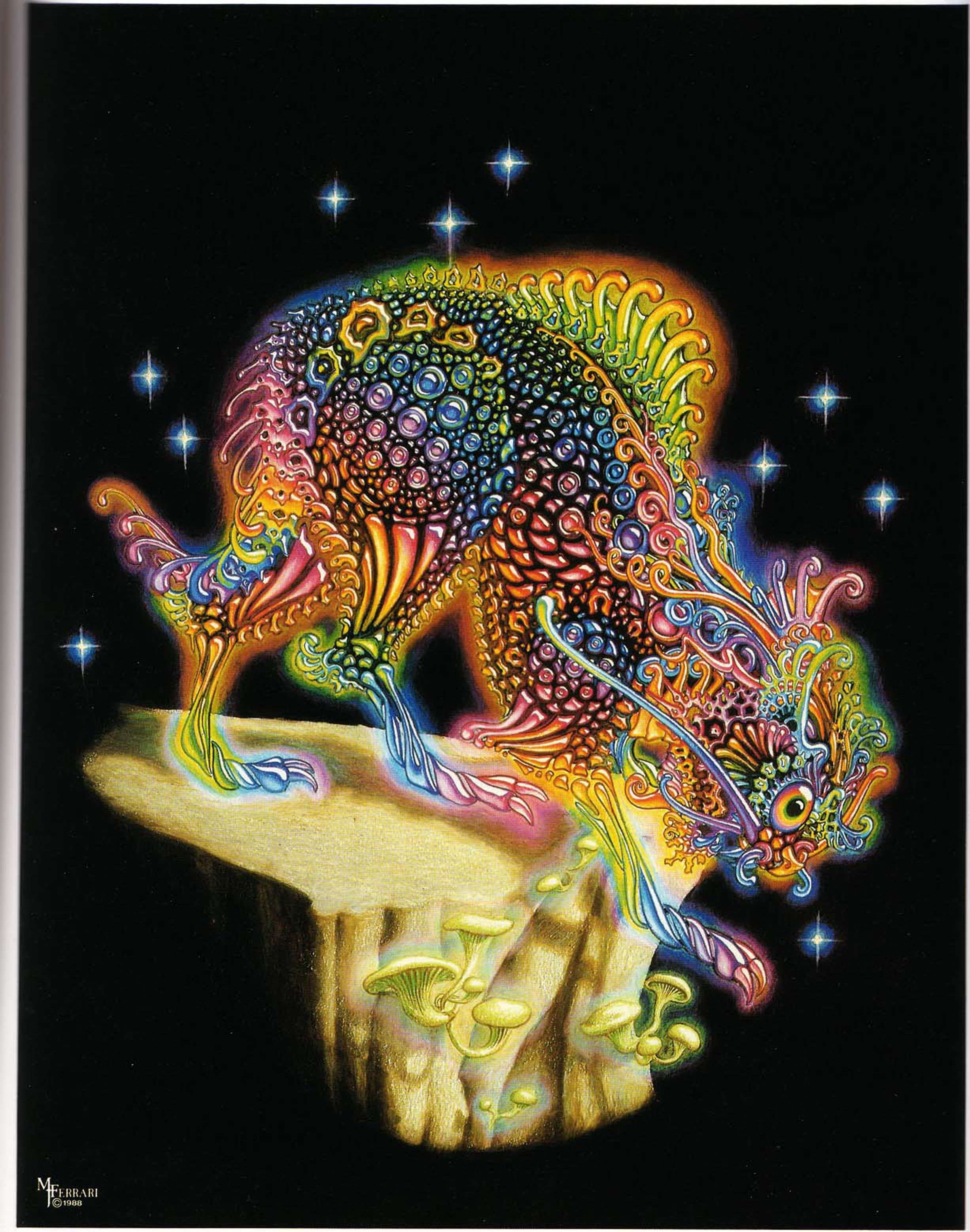

COMPARATIVE SIZE CHART, 3’ INTERVAL
Sample Arms
The Cloudbeast’s astonishing ability to make solids of vapor is even more amazing close up. Here two brachiate versions are shown, the left for grappling and anchoring, and the right for grasping prey the size of humans or zebras. The strength depicted is not artistic license: such arms could successfully wield several u tons weight.
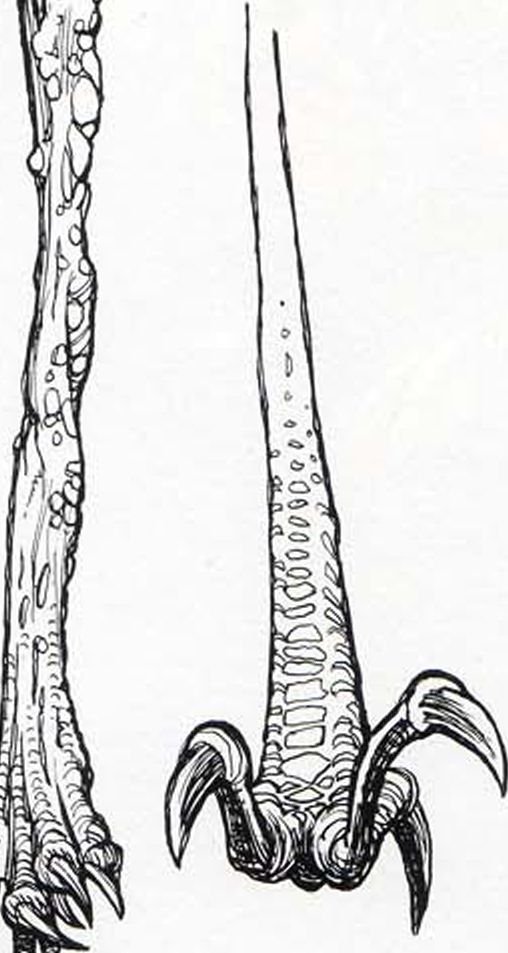
“From my experience I cannot doubt but that man, when lost to terrestrial consciousness, is indeed sojourning in another and uncorporeal life of far different nature from the life we know; and of which only the slightest and most indistinct memories linger after waking. From those blurred and fragmentary memories we may infer much, yet prove little.” — H.P. Lovecraft.
Cloudbeast
A Cloudbeast resembles an animated cloud. It can at will form bulbous eyes, twisted mouths, long ropy limbs, and other organs out of its mass, as well as resorb such items into its vaporous mass when desired. It is completely silent at all times. Nine different types of limbs - brachiate, ctenic, ocular, pedical, remular, scindiate, stomatic, vacuolated, and velumar - have been described (Marsh, 1976).
This carnivore, though stupid, is persistent and well-adapted to the hunt, finding it nearly as easy to seize a shipload of humans as to siphon up a school of tuna.
Habitat: open air, usually near or on an ocean, especially along temperate and tropical storm tracks.
Distribution: though rare, the Cloudbeast has been found across the Southern Sea and adjoining territories. Marsh (ibid.') claims that it does not originate in Earth’s Dreamlands at all, but from another world’s dreams, a theory supported by the creature’s bizarre constitution and metabolism.
Life and Habits: floating freely over land and sea, the beast seeks food. Spotting a likely meal, it drops slowly towards the intended prey. Victims of the Cloudbeast are converted into mist themselves, and incorporated into the creature. The digestive mechanism is poorly understood.
When a Cloudbeast becomes large enough (70-100 meters in diameter), it rises to an altitude as high as five kilometers, then bursts into several smaller beasts. The offspring from this mitosis average 8-12 meters across.
A Cloudbeast may grow and shrink many times during its 20-30 year lifetime. Periods of stress lessen the creature’s volume, while prosperous feeding increase it. It is remarkably resistant to injury: wounds simply reform or refill themselves.
Distinguishing Cloudbeasts —
-
♦ Blupes are much smaller, transparent, and do not form long, thin limbs from their body substance;
-
♦ Lamp-efts have definite shape, glowing eyes, and are much smaller.
Fig. 10 — Two versions of brachiate pseudopods.

21'.
18'.
15'.
12'.
9’.
6’.
3'.
0’
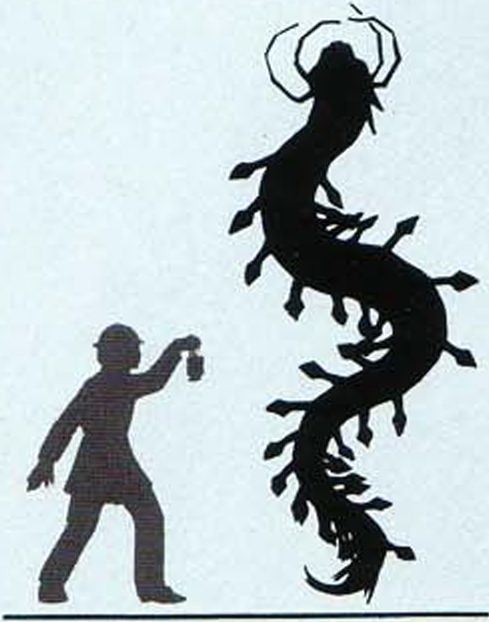
COMPARATIVE SIZE CHART, 3’ INTERVAL
Associated Species
Cousin to the Fireworm, the Boltworm of the Bnazie Desert accumulates enormous static charges during its travels, releasing sparks and lightning to stun or kill its prey and (every decade or so) sending sheets of lightning skyward during courtship dances.
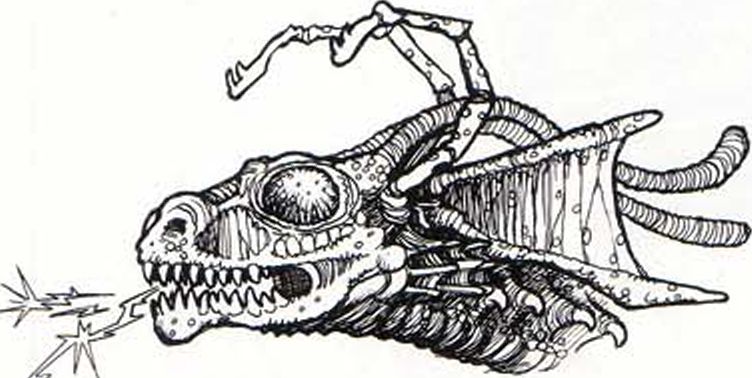
Fig. 11—Head and antennae.
“There are strange things in the great abyss, and the seeker of dreams must take care not to stir up or meet the wrong ones.”
— H.P. Lovecraft.
Fireworm OF PARG
This serpentine animal glows faintly from cracks in its segmented armor, emitting little swirls of phosphorescent smoke. It is limbless. A Fireworm varies in length from two to fifteen meters, averaging four to five meters. We choose it as representative of the many bizarre and spectacular dwellers of the Parg jungle.
Habitat: deep jungle. The Fireworm is nocturnal. During daylight hours it retreats inside hollow logs, under detritus, or within long, shallow burrows dug in the damp humus. Failing that, it heaps walls of earth around its hissing coils.
Distribution: Parg and environs. Every fifty years the Fireworm swarms in great numbers, devastating the land. Then the species dies, and none are seen for at least a decade. The last such plaguecycle occurred in parallel calendar year 1965 A.D.
Life and Habits: this large terrestrial creature lives and hunts solitarily, feeding upon coal, peat, and certain animals. The Fireworm is too conspicuous to chase down or ambush ordinary prey such as deer or apes. However, many Parg creatures are slow-moving or even blind, nearly immune to predators by virtue of magic or strange abilities - for instance, the Razortongue, the Witch Tree, the Sloblubikik, and the Sluggoc, respectively use powerful magic, mobile boughs and twigs, invisibility, and acid slime as defenses. The Fireworm preys upon such creatures. Fireworms have devasted several human villages, treating these fixed locations like cafeterias.
Its glowing form warns off most would-be enemies. When menaced by a Nightrider or Growleywog, the Fireworm rears up, bursts into flame, and snaps ferociously at its assailant. Its flame can level sections of the forest to allow mating dances and to make room to build the characteristic wood and earth mound above its nest. A Fireworm frustrated by a wooden wall or building may incinerate the structure.
The Fireworm’s segmented plates vibrate with a faint chattering sound, used to communicate with others of the species. Breeding frequency depends upon local food supply and temperature, but occurs year-round. Related species exist: one produces superheated gas instead of fire and lives in the Bnazie Desert (Treer, 1984).
Distinguishing Fireworms —
-
♦ Serpent People have legs and arms, and are usually smaller;
-
♦ Vooniths have forelegs, are amphibious, and are scaly rather than plated and jointed.


“I cannot think of the deep sea without shuddering at the nameless things that may at this very moment be crawling and floundering on its slimy bed, worshipping their ancient stone idols and carving their own detestable likenesses on submarine obelisks of water-soaked granite.”
— H.P. Lovecraft.
(inor
A finned and bearded undersea dweller, the Gnor resembles a merman. A particular Gnor may have two, three, or four arms at random; there are no subspecies in this regard. The three-armed Gnor is always asymmetric, as the illustration on the facing page demonstrates. All Gnorri are ovoviviparous.
The Gnor has neither legs nor tail: the torso ends in a long tentacle. The spiral undulations of this tentacle propel the Gnor when swimming. To creep along the sea bottom, the Gnor’s tentacle slithers ahead like an obscene boa-constrictor, gripping convenient objects to pull the Gnor along.
In a random sample of 532 Gnorri, Meeb (1986) found that 37 were four-armed, 236 had three, and 259 had two arms, an incidence of 7%, 44%, and 49%, respectively.
Habitat: the continental shelf in temperate and tropical climes; Gnorri lack sufficient insulation for polar temperatures.
Distribution: salt seas of the Dreamlands.
Locomotion
A Gnor ordinarily swims by the flicks of its long tail behind it. Occasionally it may stalk prey by pulling itself along by means of the many suckers present on its lower body; more rarely, it may wrap its flexible tail around an outcrop or a post and then pull itself forward by those tail muscles alone.

Fig. 12a—Gnor extends tentacle.
Life and Habits: Gnorri build grottoes in which to live, harvest seaweed and herd sea creatures, and craft fine goods for trade.
The characteristic Gnor structure is the maze, a complex set of tidal-zone buildings at once used as living quarters, worship sites, and fish traps. Most mazes are completely submerged tunnels of carefully-hewn coral or rock. Frequently the workmanship of these structures is excellent, and researchers regard Gnorri mazes as much as aesthetic glories as utilitarian or defensive works.
In the infamous Bight of Benna (located east of Sarkomand) exist square miles of convoluted stone walls rising several meters above mean high tide. Part of this long-abandoned Gnor maze is open-topped and part is roofed, so that small boats navigating the narrow grottoes are sometimes in light, sometimes in shadow, sometimes in impenetrable gloom. Bold dreamers have explored portions of this enormous labyrinth. Such a structure must have performed a special function, but casual investigation has failed to divine the purpose.
Distinguishing Gnorri —

Beings from lb have hind legs;
Moon-Beasts are not aquatic and have no visible sense organs other than clusters of snout-tentacles.
Fig. 12b — Suction cups grip, allowing forward pull.

TERRARl
I ©1988
21'.
18’.
15'.
12’.
9’.
6’.
3’.
O'

COMPARATIVE SIZE CHART, 3’ INTERVAL
“He prayed long and earnestly to the hidden gods of dream that brood capricious above the clouds on unknown Kadath, in the cold waste where no man treads. But the gods made no answer, and shewed no relenting, nor did they give any favouring sign . . . .”
— H.P. Lovecraft.
Great One
Under the auspices of the alien Outer Gods, these preternatural entities loosely govern Earth’s Dreamlands. How the Great Ones obtained such sponsors and what benefit the Outer Gods derive from the relationship remains unknown.
With one exception (see sidebar), Great Ones resemble humans of a distinct racial type. Each has long narrow eyes, long-lobed ears, thin noses, and pointed chins - visages interestingly similar to Easter Island statues (Isinwyll, 1975). A Great One can walk through the air as easily as over the ground, and can enter other planes of existence. Some Great Ones appear to be versions of familiar Earthly deities such as were in the Roman pantheon.
Habitat: any earthly environment.
Distribution: the traditional home of the Great Ones is Kadath, associated with the Plateau of Leng. Kadath may or may not be actually located on the Plateau.
Hagarg Ryonis
Great Ones ordinarily have human form. Not Hagarg Ryonis - a statuette captures her grotesque bestiality. Made of black horny plates and with six glowing eyes spaced irregularly over her body, she is about the size of a horse. Teeth and claws are of black glass, and her claws drip a slimy liquid: this Great One enjoys ambushing prey.

Life and Habits: Great Ones often visit human areas, even crossbreeding with us - the people of Inganok contain Great One blood (Carter, 1939). Despite their great powers, one may trap or overwhelm a Great One by using skill, wit, and hyperdimensional science, but the attempt is dangerous, and not only because Great Ones are powerful: success risks intervention by the Outer Gods, with extreme consequences for the human.
Distinguishing Great Ones —
Several of the best-known Great Ones follow:
-
♦ Karakal, portrayed encircled by flames, can start fires at will and is lord of entities known as the Minions of Karakal (7.V.);
-
♦ on the facing page, Lobon is at the left (the spear is his personal emblem, but he is no war-god);
-
♦ Nath-Horthath, the god of Celephais, appears as a black-skinned human with blond hair and pupilless silver eyes, always accompanied by at least one lion;
-
♦ a silver-skinned god with coal-black hair and beard, clad in cloth-of-gold, Tamash is a master of illusion and can create apparitions and hallucinations with precision;
-
♦ on the facing page at the right, Zo-Kalar is regarded as god of birth and death.

21'
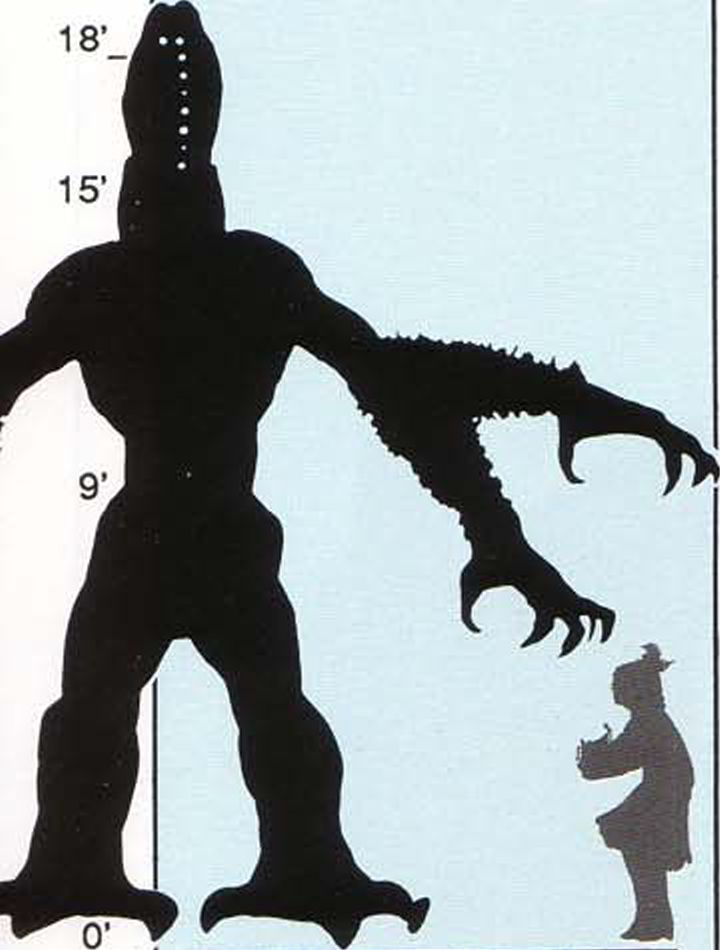
COMPARATIVE SIZE CHART, 3’ INTERVAL
The Gug Jaw
The powerful muscles of the Gug’s jaw are at rest when the vertical hinge is closed, not open (as with primates), supplying a excellent reason why Gugs do not speak. Special supplementary muscles allow the jaw to lock at two stages of openness.

Fig. 14 — Gug skull.
“The gugs, hairy and gigantic, once reared stone circles . . . and made strange sacrifices to the Other Gods and the crawling chaos Nyarlathotep, until one night an abomination of theirs reached the ears of earth’s gods and they were banished to caverns below. . . . That a mortal dreamer could traverse their cavern realm and leave by that door is inconceivable; for mortal dreamers were their former food, and they have legends of the toothsomeness of such dreamers.”
— H.P. Lovecraft.
Gug
A Gug is a species of shaggy cannibal giant, restricted to life underground by a curse of the Great Ones. From each of its black-furred arms sprout two forepaws, equipped with dreadful talons. Its legs and feet are bird- or dinosaur-like, and patches of greasy black fur cover its body. The face of a Gug is especially terrible, with bulging pink eyes set on bony swellings and a ghastly fanged mouth splitting the head vertically. Voiceless, the thing communicates by facial expression and gesture.
Habitat: as intelligent beings, almost anywhere. The species quickly adapted to caverns after banishment from the surface world.
Distribution: currently restricted to the Underworld, through fear of the Great One curse. A Gug kingdom exists; individuals wander throughout the Underworld.
Life and Habits: These giants superstitiously avoid Ghouls (who regularly visit Gug graveyards), feeding primarily upon Ghasts which they hunt down in the lightless Vaults of Zin. Gugs have peculiar and despicable reproductive practices; see Treer (1984) for particulars.
Most Gugs live in a horrible walled kingdom-city where Cyclopean round towers soar endlessly into the black air overhead. Each tower has a single black portal, thirty feet high. Rough stone paves the whole of the city (Carter, 1927). At the city’s center is the sign of Ko th, on a great central tower leading to the surface of the Dreamlands. No day or night exists in the twilight realm, and a Gug usually sleeps immediately after gorging on loathsome provender: just after general feast-time may be the best time to penetrate this place. Ghast raiders, occasionally attacking then, may imperil researchers.
Distinguishing Gugs —
-
♦ The Beings from lb are much smaller and more rubbery;
-
♦ Men of Leng are much smaller, with only two arms and normally-placed facial features;
-
♦ Tsathoggua has a squat, toad-like appearance, and a horizontal mouth.


COMPARATIVE SIZE CHART, 1.5' INTERVAL
After Feasting
Having drunk its fill, the swollen Haeomophore drags itself to a nearby hiding place to sprawl there soddened and satiated. So bloated, this creature may not begin a new hunt until 3-4 months have passed.

Fig. 15 — Distended Haemophore.
“Who are we to combat poisons older than history and mankind? Apes danced in Asia to those horrors, and the
cancer lurks secure and spreading where furtiveness hides in
rows of decaying brick.”
— H.P. Lovecraft.
Haemophore
It is a small being with large webbed feet. Huge suckers adorn the front and ventral areas of its body, with which it attaches itself to prey animals. The Haemophore subsists entirely on blood. Its small W-shaped mouth conceals a series of hollow needle-like fangs used to suck fluid from a victim. This species has not been proven to carry diseases, though (oddly enough) survivors of its attacks often report subsequent arachnorhinitis.
A hermaphrodite, the Haemophore breeds underwater, giving live birth to tiny, two-tailed aquatic larvae. Those swim blindly through the water. Contacting a potential host, a larva sheds its tail and burrows into the flesh. Within seconds it is buried beneath the host’s skin, leaving a 2mm-diameter hole which quickly stops bleeding. The larva migrates to the host’s digestive tract, there feeding, growing, and altering form for a month to six weeks, until it attains adult shape and is some 50mm (2") long. It then exits the host and hops away to begin life on its own, reaching full size in a year or two (Dannseys, 1978).
Habitat: any moist, rocky area. Caverns, lakeside ruins, and sea cliffs are perfect dwelling-places.
Distribution: on Oriab Island, and probably elsewhere.
Life and Habits: the timid Haemophore carefully investigates potential prey before attaching itself. Shiny objects and hoard gewgaws such as pendants, earrings, buckles, grommets, and eyeglasses specially attract it.
The creature sometimes attacks conscious targets, but prefers sleeping ones, secreting a powerful anaesthetic to eliminate sensation in the punctured area. In either case, the Haemophore’s stomach-suckers grip firmly as it then exsanguinates the victim at an alarming rate; it swells to appalling proportions to contain the incarnadine plunder. One 70cm-long Haemophore can completely drain the blood of an adult zebra.
The now-bloated bloodsucker is awkward and vulnerable. It hides, having stolen enough blood for one or many months - lucky Haemophores need eat only once or twice a year. Any Haemophore can go without food for several years. If starving, it weaves a slimy cocoon within which to aestivate, emerging up to a century later. Distinguishing Haemophores —
♦ Zoogs are smaller and furry, with long tails.


Projection Lamp
The Lamp-eft can, at will, create an intense beam of light with each of its optical transceivers.

Fig. 16 — Cutaway view, optical transceiver.
“There came to that room wild streams of violet midnight glittering with dust of gold; vortices of dust and fire, swirling out of the ultimate spaces and heavy with perfumes from beyond the worlds. Opiate oceans poured there, litten by suns that the eye may never behold and having in their whirlpools strange dolphins and sea-nymphs of unrememberable deeps.” — H.P. Lovecraft.
Lamp-eft
A Lamp-eft is a glowing salamander-like creature about a yard long. It has two huge globe-like eyes, but no mouth. It naturally floats in the air, propelled by paws and a flattened tail. A /nme-like organ allows its writhing flight, but may not grant interstellar or even interplanetary movement (Hike, 1981; Webber, 1973).
Habitat: normally inhabiting the Dreamlands stratosphere and mesosphere, descending to the surface at night or not at all.
Distribution: the upper air. In view of the Lamp-eft’s ability to ignore gravity, indifference to vacuum, and utility (Webber, ibid.), the species possibly inhabits the upper atmospheres of other Earthlike worlds as well as layers in Jovian atmospheres.
Life and Habits: it feeds from the ambient energy (sometimes given the misnomer life-force) which all living organisms generate each day. It needs little to survive, an amount easily regenerated by the average target creature. Loss of such energy does render the host somewhat more susceptible to disease and psychic obsession. Should a Lamp-eft completely drain a small animal of ambient energy, the victim may lose consciousness for up to a full day. No evidence exists that Lamp-efts cooperatively select and drain particular targets, despite rumors (Marik, 1989).
In the Dreamlands, circuses and smaller travelling shows often feature Lamp-eft teams trained to perform rapid loop patterns parallel to the ground, like swirling hoops. If not performing, they may help illuminate high-wire artists during evening performance.
The Lamp-eft is easily tamed and a pleasant companion, despite a sometimes comical or annoying inquisitiveness. Pretematuralists and hard metaphysicians often keep several as live-in defenders against alien entities vulnerable to light, such as Shades and Hunting Horrors.
Distinguishing Lamp-efts —
-
♦ Basilisks do not glow, are winged, and have two legs;
-
♦ Butterfly-Dragons do not glow and are winged;
-
♦ Cats from Saturn do not project beams of light, and have glittering, granuled integuments;
-
♦ Minions of Karakal have limbs resembling lightning flashes, and smell of ozone.
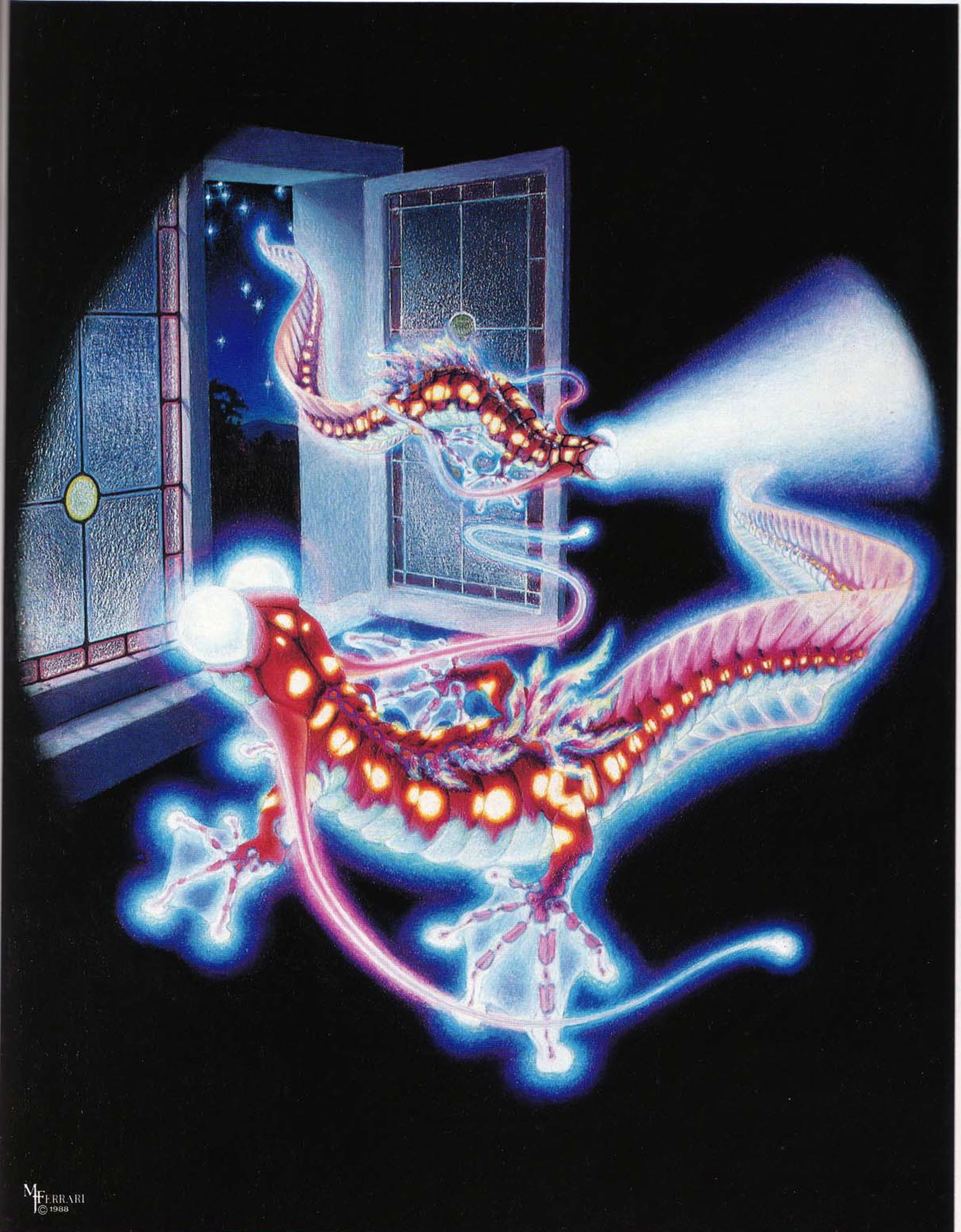

Comparative Growth
Figure A shows a first-stage Larva, at drift in the universe: its length is about 5 meters (15 feet). Figure B depicts the second-stage of the Larva, now planet-bound, strolling across a field of tombstones: it is now about 40 meters (131 feet) across, and

“That hellish bird plunged onward through shoals of shapeless lurkers and caperers in darkness, and vacuous herds of drifting entities that pawed and groped and groped and pawed; the nameless larvae of the Outer Gods, that are like them blind and without mind, and possessed of singular hungers and thirsts.”
— H.P. Lovecraft.
Larva OF THE outer gods
A Larva of the Outer Gods may take any of an infinite number of weird shapes and conformations. Many are shape-changers. Any Larva is immortal and nearly impossible to destroy (Barzai, 1572). Although a Larva does not need to eat to survive, it always reacts hungrily or curiously to the passage of travelers. Every voyager is alarmed by these great and ominous forms but, so long as one keeps moving, Larvae rarely become dangerous.
Habitat: outer space.
Distribution: likely the entire universe.
Life and Habits: at the center of the universe, the Outer Gods writhe and dance eternally around Azathoth, the Demon Sultan. Periodically a blast of consciousness from an Outer God provokes a Larva into existence. Once created, it is ignored and left to wander into the universe (Dannseys & Marsh, 1972). Most Larvae drift forever through planetary/interstellar/intergalactic space, scattered without end, unaffected by heat, cold, light, darkness, or gravity.
Occasionally, however, for unknown reasons and in an unknown way, a Larva is stimulated into a gradual transformation: over decades or perhaps centuries (Isinwyll, 1987), the movement of the thing becomes purposeful and an orbit can be detected. Once so-moving, its appearance normally ’thickens’ indefinably. At the end of an often-lengthy journey, the Larva leaves outer space to reside on a planet, a dark star, or other interstellar object. As millennia pass, the new resident gains in strength and power to become a full-fledged Outer God, after which it may begin the eons-long trip to Azathoth’s throne.
The great majority of Larvae remain forever in the original larval state. Many more make only a partial journey - transforming into Outer Gods, but then becoming permanent and unwelcome habitants of the worlds to which they came, never leaving to join the mindless spasms of Azathoth. Great Old Ones are no longer believed to be nascent Outer Gods, and should not be confused with Larvae.
Distinguishing Larvae of the Outer Gods —
♦ The infinity of larval shapes makes useful distinction impossible. Rely upon their habitat (outer space) and behavior to identify them.
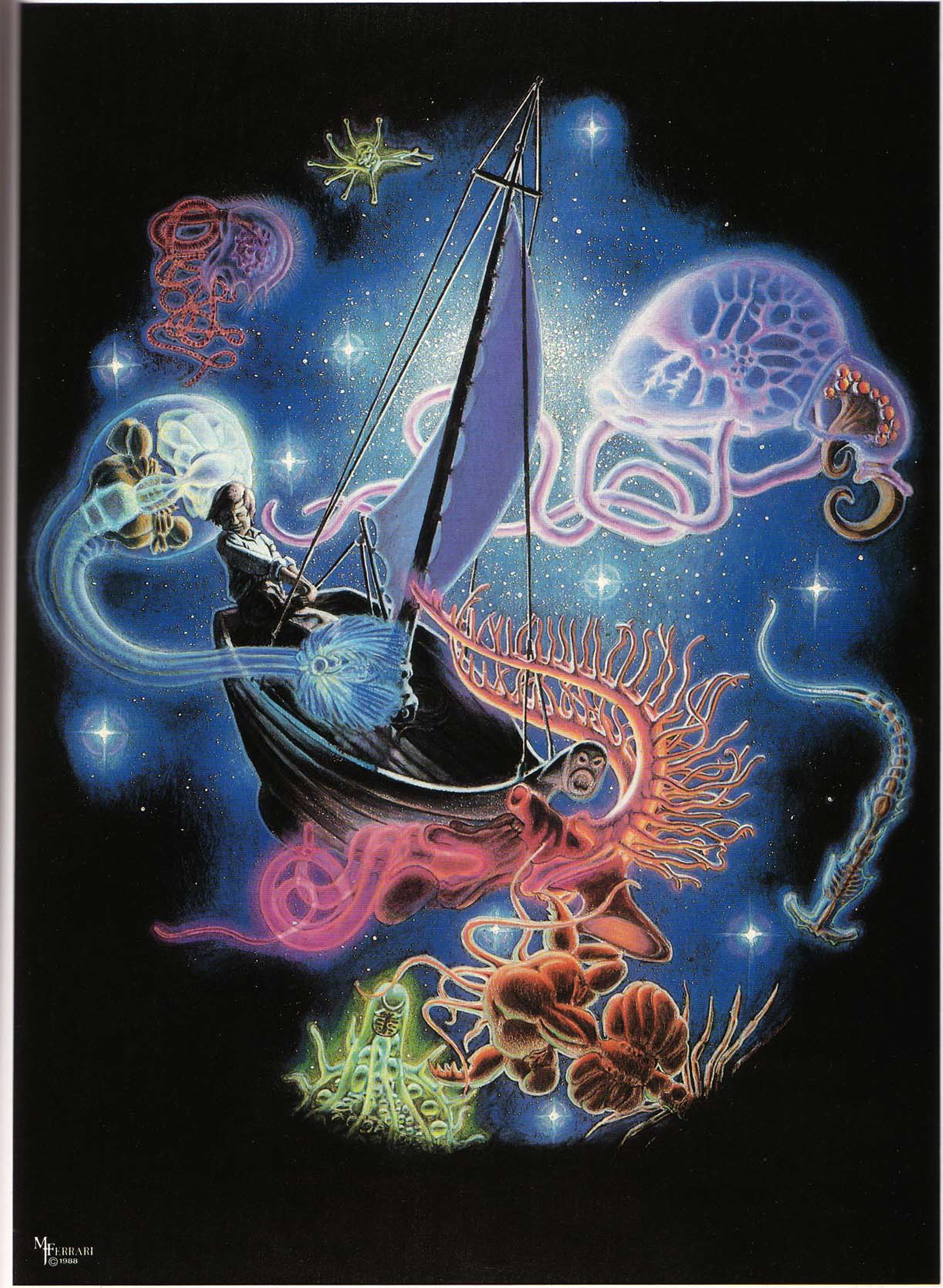
2T_ __________________
This young specimen will reach adulthood in another
1 g’ 4-5 years.
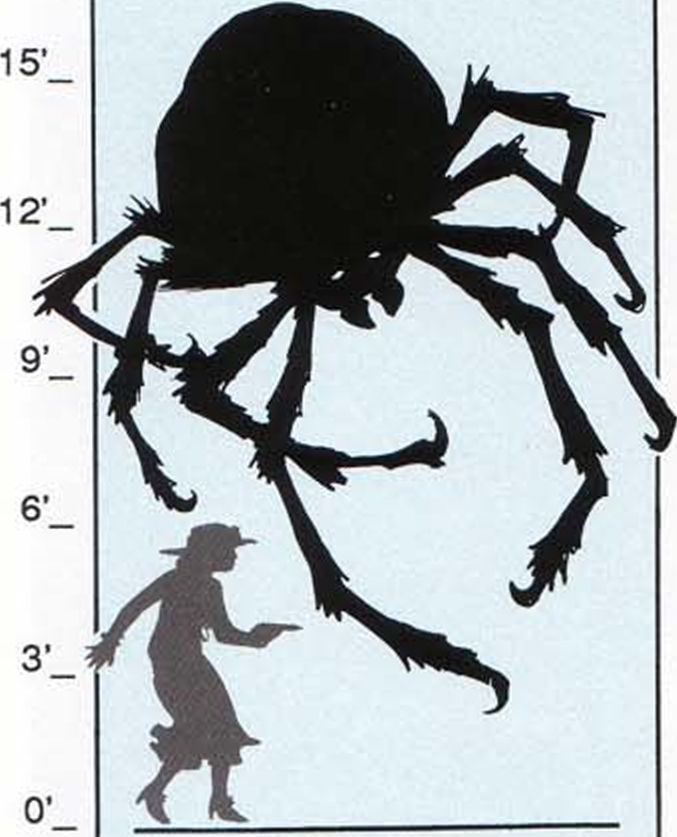
COMPARATIVE SIZE CHART, 3’ INTERVAL
“It is absolutely necessary, for the peace and safety of mankind, that some of earth’s dark, dead corners and unplumbed depths be let alone; lest sleeping abnormalities wake to resurgent life, and blasphemously surviving nightmares squirm and splash out of their black lairs to newer and wider conquests.”
— H.P. Lovecraft.
Leng Spider
A bloated purple spider of appearance similar to a normal spider, its tremendous size and intelligence distinguishes the Leng Spider. Internally, specialists find significant differences from other spiders. Treer (1984) recommends placing the species as the suborder Humungognatha, within the order Aranea.
The Leng Spider never stops growing. An average specimen weighs up to 1.5 metric tons and is 2-3 meters (7-10 feet) long; individuals of 12 tons and 5-6 meters (20 feet) long are not uncommon. Deep in their territory, 80-ton colossi 8-12 meters long have been reported (Wasling 1971).
In ancient times, the humanoids of Leng waged bitter struggles with the Leng Spiders. These conflicts would appear to have been settled in favor of the almost-humans, as the Leng Spider range is today quite restricted (Meeb, 1979).
Habitat: nests in gorges, caves, crevasses, and similarly sheltered areas. The Leng Spider feeds on yaks, vultures, shantaks, and other large animals entering its toils. When young, it travels extensively, searching for an appropriate lair, but in adulthood it becomes sedentary, rarely moving a few hundred yards from its den.
Distribution: the southern edge of Leng; rarely outside there.
Life and Habits: purely carnivorous. Since the Leng Spider is intelligent, its web arrangements are not instinctive, but are chosen with an eye for actual location and potential prey. Therefore the
A Leng Trap
-
(A) Foolish traveler grabs at large twinkling jewel attached to web;
-
(B) web pulls trapdoor release;
-
(C) trapdoor falls from beneath the weight of the investigator and the boulder counterweight; (D) bolt releases from slot in trapdoor; (E) the boulder drops down; (F) the boulder plugs the chamber, safely capturing — because spiders prefer living prey - the incautious boob. The racket alerts the Leng Spider to its fresh catch.
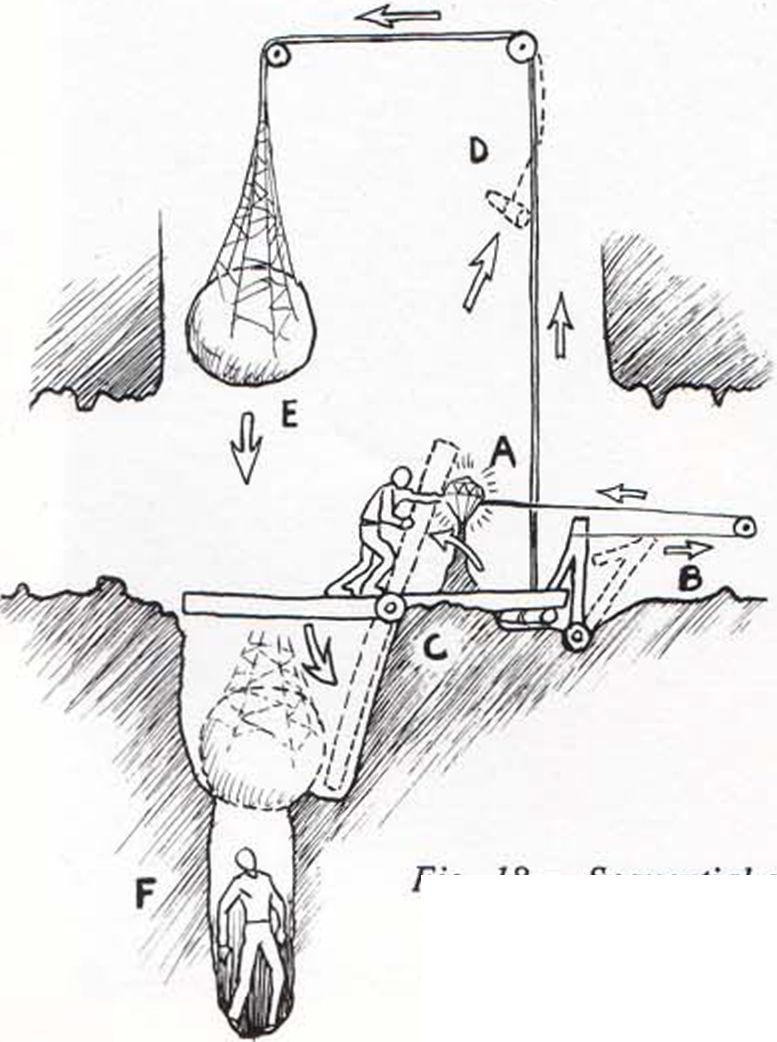
web is not spun in a stereotyped orb or funnel, and varies greatly from spider to spider. Its webline is much stronger and more elastic than tempered steel cable.
The Leng spider deploys its web subtly, blocking off escape routes, creating runways for itself, and laying traps. A Leng Spider snare is ingenious, perhaps incorporating camouflaged triplines, deadfalls, and nooses (Wasling, ibid.}. Exercise extreme caution. Distinguishing Leng Spiders —
-
♦ Atlach-Nacha has striking red markings and a humanoid face;
-
♦ Minions of Karakal are small, and are composed of lightning sparks and clouds of energy;
-
♦ Wamps are smaller, have white and red markings, and are mammalian in general physique and appearance.

10.5’_
9’_
7.5’_
6’_
4.5’_
3'_
1.5’_
O’

Magah Nest
A tear-drop shape, the Magah Bird’s well-engineered nest dangles from a high jungle bough. Such a nest weighs 12-15 kilograms and may contain 3-5 hatchlings. Note the defensive spines intended to foil arboreal
predators.

Fig. 19 — Nest reinforced with rikrok vine.
“The whole air was fragrant with balsam, and all the magah birds sang blithely as they flashed their seven colours in the sun.”
— H.P. Lovecraft.
IVIagali Bird
A Magah Bird is small, beautifully-plumaged, and carnivorous. Its feathers are long and lustrous. Unusually among birds, the Magah female is as dazzling as the male, probably because the species’ colorful plumage is intended not for courtship but for attracting and catching prey.
Every Magah has a wide range of songs, sung for specific reasons; most melodies are quite lovely. Every song is capable of inducing an emotional reaction in a listener. The Magah courtship song is a known aphrodisiac to many mammals (Meeb, 1988), while the Magah warning cry is capable of frightening quite large animals. Habitat: Brush and forest, but not deep jungle or wastelands. They nest in large trees, preferring magin trees probably because that tree’s long curly leaves are well-suited for walling Magah-style nests. Despite a similarity in name, the magin tree is not named after the Magah Bird.
Distribution: the Magah Bird is found throughout the southern Dreamlands. This avian does not migrate, and cannot survive (except as a captive) in areas subject to heavy frost and snow.
Life and Habits: this predator enjoys prey ranging from lizards and mice to small monkeys and sizable snakes.
Animals too large to be subdued by the bird’s sharp beak may be captured by hypnosis. The Magah Bird is capable of singing a special hunting song directed at a single prey animal. If the animal fails to shake off the lassitude induced by the song, the target falls into a trance-like state and staggers slowly forward toward the singing bird. Once the bird strikes, the hypnotic effect ends - too late for the target.
Nearby animals which are not specifically targeted by the Magah Bird are not seriously affected by the hunting song, though often they become drowsy. Dannseys (1986b) believes that precision of the song’s direction is based on the bird’s correct display of its plumage. Thus the prey animal is hypnotized not by song alone but by a combination of song and an enhancing presentation of plumage and movement. Were they possible, high-quality recordings of Magah songs alone would have little effect on listeners.
Distinguishing Magah Birds —
♦ Butterfly-Dragons are much larger and have no feathers.

21'_
18’_
15’_
12’_
9’_
6'_
3'_
O’_
“Around the feeble fires dark forms were dancing, and Carter was curious as to what matter of beings they might be; for no healthy folk have ever been to Leng, and the place is known only by its fires and stone huts as seen from afar. Very slowly and awkwardly did those forms leap, and with an insane twisting and bending not good to behold; so that Carter did not wonder at the monstrous evil imputed to them by vague legend, or the fear in which all dreamland holds their abhorrent frozen plateau.”
— H.P. Lovecraft.
COMPARATIVE SIZE CHART, 3’ INTERVAL
Possession
Most Moon-Beasts mark their Lengite slaves with patterns of raised welts and scars, showing to whom the slaves belong. In commentaries, the Moon-Beasts extoll not so much propertarian rights as the discipline imparted to slaves by the intense and extended sensations of scarification.

Fig. 20 — Nibbosht clan marking, Tsiolkovski correspondence region.
Man Of Leng
This humanoid species is equipped with horns, hooves, and a dwarfish tail. Swaths of matted body fur occur in patches. The mouth is wide and toothy.
The Man of Leng’s origin and evolution are obscure. Researchers agree that resemblances to Homo sapiens are the result of convergence. In a ground-breaking dissection of a Lengite hand, Meeb (1986) demonstrated musculature significantly different from that of primates.
Since prehistoric times the species has dwelt in Leng, an arid and frigid plateau. A Lengite city, Sarkomand, was ruins a million years before the first human crept out of the jungle. That civilization decayed, or fell in conflicts with races such as the Serpent People.
Long after their fall, the Men of Leng were invaded and subdued by the Moon-Beasts. They permitted their new subjects to continue to rule Leng, taking Lengite slaves as tribute: fat ones became food; thin ones became laborers. The most human-like slaves are still used as go-betweens with humans (Fallworth, 1939). Habitat: originating in cold stony wastes, they thrive best there (the Dreamlands Moon is perfect for them). But the species can prosper in more pleasant climes.
Distribution: the Plateau of Leng and the Dreamlands Moon, transported to the latter by the Moon-Beasts. Representatives of the species may have been conveyed elsewhere as well.
Life and Habits: the two sexes live much like humans, with the addition of certain monstrous customs. They dwell in little stone villages, keep herds of loathsome cattle, grow fields of unhealthy crops, and gleefully engage in gruesome festivals. The enthusiastically horrific treatment they reserve for human captives and visitors makes difficult their systematic study.
Distinguishing a Man of Leng —
-
♦ Beings of lb have frog-like skins and bodies, and are hairless;
-
♦ Gugs are much larger, with less human-appearing faces;
-
♦ Serpent People have snake-like heads and long tails.
1MVHH3

21’.
18’.
15’
12’_
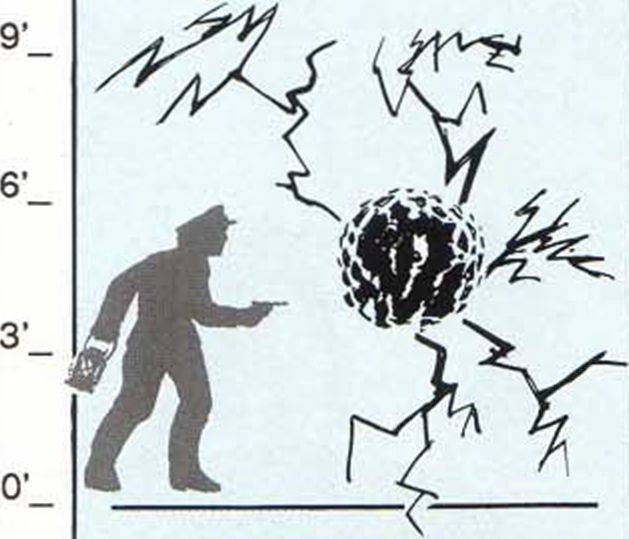
COMPARATIVE SIZE CHART, 3' INTERVAL
Religious Dedication
Minion of Karakal colonies always include a place to worhip Karakal, their master. Here the altar is a 2-meter stone cube topped by a bowl of fire as an offering. The smiling solar face represents the benevolence of
Karakal.

’’With five feeble senses we pretend to comprehend the boundlessly complex cosmos, yet other beings with a wider, stronger, or different range of senses might not only see very differently the things we see, but might see and study whole worlds of matter, energy, and life which lie close at hand yet can never be detected with the senses we have.”
— H.P. Lovecraft.
IVIinion of karakal
A Minion of Karakal is made of crackling electricity. Its spider-like legs are black and red lightning bolts, continually flashing out of and then resorbing into the creature’s body. The small cloudy body is shot through with flashes of red. A Minion has no visible head or sense organ. It floats in the air, or propels itself by rhythmic undulations of its electrical limbs.
Habitat: the Minion of Karakal is native to the Dark Dimension. It is not naturally found elsewhere. The creature dislikes moist surroundings. In Earth’s Dreamlands, it deteriorates at a rate variable with the humidity: it survives indefinitely in perfectly dry surroundings; in 90% humidity, it dissipates in a week or two. Direct precipitation destroys it in minutes.
Distribution: the Dark Dimension. It occurs elsewhere as a result of sorcerous incantation or the invocation of Karakal. Minions range throughout the Dark Dimension, but cluster at the Hall of the Flowing Stones (Webber coordinates W.525, X.7316, Y.5300, Z.94804).
Life and Habits: this is a lethal entity. A single touch delivers a lightning-strength bolt causing third-degree burns, charring holes through leather, and stopping human hearts. Careful research (Gillman, 1979) indicates a 32% chance of significant heart fibrillation inflicted by Minion of Karakal attack. Proper techniques easily control this entity, and many Dreamlands hard metaphysicians employ the species for security purposes. Unfortunately, the Minion’s deadly potential also renders it suitable for criminal misuse.
In this universe, at least, the Minion subsists by subsuming static charges. As yet we lack knowledge of Minion life-span, mating, reproduction (if any), and other basic data. The explosion of preternatural knowledge in the last decade threatens to utterly overwhelm scholarly procedure.
Distinguishing Minions of Karakal —
-
♦ Cats from Saturn do not spark or give off energy, and have a crystalline appearance;
-
♦ Lamp-efts possess four legs and have glowing eyes;
-
♦ Atlach-Nacha and the Leng Spiders are larger and non-electrical.
-51 -

21
18’_
15’_
12’_
9'_
6’_
3’_
O'
11
COMPARATIVE SIZE CHART, 3’ INTERVAL
Storing Information
For many geologic ages the Serpent People have kept important information on thick triangular plates made of various non-corrosible metals. The text reads from each tip of the triangle. This particular plate outlines an important hypergeometrical relationship implicit in planetary orbits.

“Not even the physical horror of my position in that cramped corridor of dead reptiles and antediluvian frescoes, miles below the world I knew and faced by another world of eerie light and mist, could match the lethal dread I felt at the abysmal antiquity of the scene and its soul. An ancientness so vast that measurement is feeble seemed to leer down from the primal stones and rock-hewn temples in the nameless city, while the . . . maps in the frescoes shewed oceans and continents that man has forgotten, with only here and there some vaguely familiar outline.”
— H.P. Lovecraft.
Serpent People
They resemble upright serpents, with arms and legs, ophidian heads and tails, and commonly wear robes of the highest quality.
This ancient race first reached prominence in the Permian Age, long before the first dinosaurs. That primordial civilization built cities of black basalt, fought deadly wars, and mastered profound chemical and hypergeometrical techniques. The species dwindled in the Triassic. In the Pliocene, Serpent People increased and once again built cities, thriving into the early Pleistocene. Now they are again a relict species, here and in the Dreamlands.
Their first civilization learned the secret of immortality, later enabling isolated scholars to contribute profoundly in epochs when civilization was prostrate.
Some Serpent People survive from earlier ages, beneficiaries of immortality. Others are atavisms to earlier, powerful versions of the species. Such individuals often lead and tend their brethren. Most Serpent People are degenerate, of limited intelligence and stunted in growth and appearance. Some crawl, rather than walking erect. Habitat: any non-arctic environment, though preferably warm. Degenerates mostly live underground.
Distribution: Worldwide. In the early Pleistocene, individuals mastered occult illusion and could take on other appearances. Some live among us now, illusion masking their true nature.
Life and Habits: a carnivore, the Serpent Man prefers live prey. At times, ultra-civilized members apparently subsisted wholly on artificial food. The species appears to hate or resent humanity and plots against us, feeling that we block their rightful reascendance to power (Lochert, 1983).
Distinguishing Serpent People —
-
♦ Beings from lb have soft, slippery hides, no scales, and no tails;
-
♦ Bokrug is lizard-like, not snake-like, and is not bipedal;
-
♦ Fireworms are limbless and have arthropod-like joints over their bodies, rather than true scales.

FERRARI ©1988
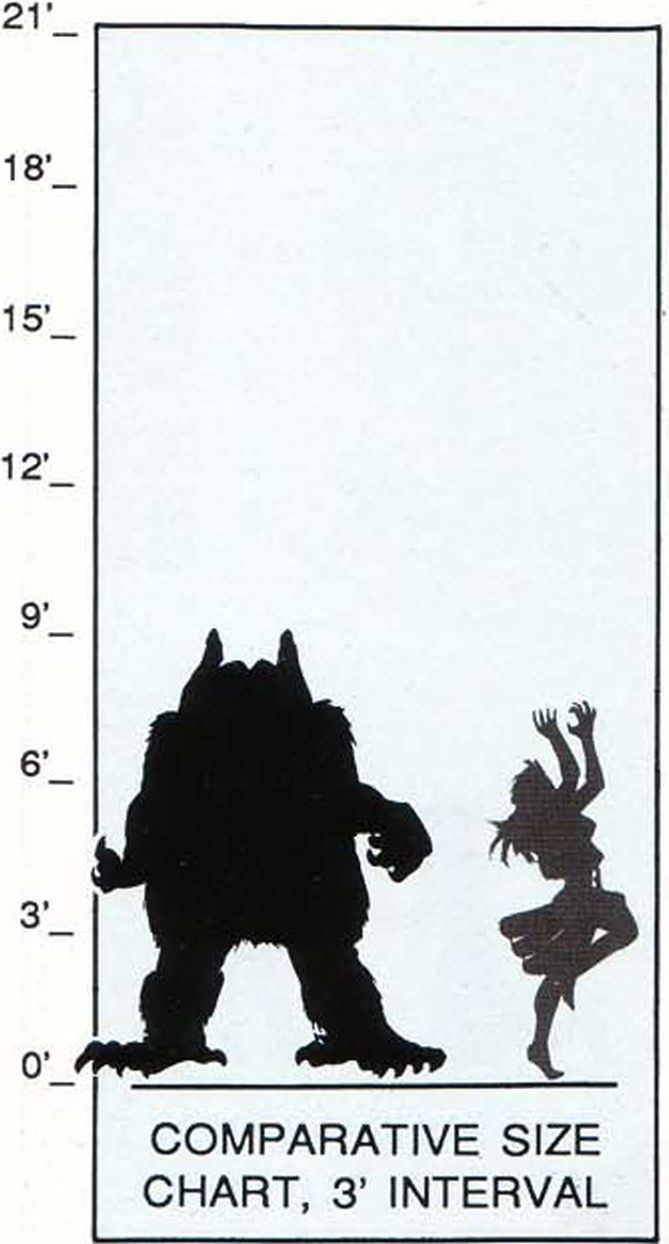
A Temple Form
By various accounts, Tsathoggua ’s temple contains one, several, or many such stone tubs, all apparently filled with lifeless black water. Each tub actually contains a quiescent Formless Spawn, shown forming pseudopods in the illustration.

Fig. 23 — Activated guardian.
“It needed the nourishment of sacrifice, for It was a god. Of course I couldn’t get It the sort of sacrifices which It used to have in Its day, for such things don’t exist now. But there were other things which might do. The blood is the life, you know. Even the lemures and elementals that are older than the earth will come when the blood of men or beasts is offered under the right conditions.”
— H.P. Lovecraft.
T sathoggua
Tsathoggua is an exceptional member of the powerful Great Old Ones. Other local members of this interstellar species include Cthulhu, Ithaqua, and Hastur the Unnameable.
On Earth, Tsathoggua is served by frightful amorphous beings known only as Formless Spawn. Perhaps he brought them with him when he arrived on Earth, or created them once here, or perhaps they chose to serve him when he arrived.
Tsathoggua came to Earth from Saturn. At least one other member of his species (a reclusive being known as Wuthoqquan’s Bane) arrived with him. Tsathoggua is the only Earthly Great Old One who has sought worship and sacrifice from humankind as well as from our furry predecessors (Smith, 1932).
Tsathoggua’s form alters in response to environment. On Saturn, he looked quite different than on Earth, as may be deduced from the form taken by Tsathoggua’s paternal uncle, Hziulquoigm-nzhah, still a Saturn-dweller (Smith, 1931b). That being has a spheroidal body, stubby legs, and long arms. The head is Tsathoggua-like, but dangles from the underside of the body; other arms and feet provide locomotion.
Evidence exists that Tsathoggua can voluntarily alter his form (Fallworth, 1944); certainly the Formless Spawn change shape and texture remarkably.
Habitat: Tsathoggua is capable of dwelling anywhere.
Distribution: Tsathoggua lives in the black gulf of N’Kai, far below the Earth’s surface. He may project his image elsewhere or even personally visit far regions of the Dreamlands, but he has shown no desire to leave N’Kai.
Life and Habits: spending most of his time in bloated sleep, Tsathoggua awakens only to accept sacrifices or answer a sorcerer’s call. If he is satiated with food, he responds to visitors in a nonthreatening, even friendly manner. If Tsathoggua is hungry, the would-be interviewer had better have an acceptable sacrifice ready, or risk consumption himself.
Distinguishing Tsathoggua —
♦ Gugs have vertical mouths and are lankier.
-55-

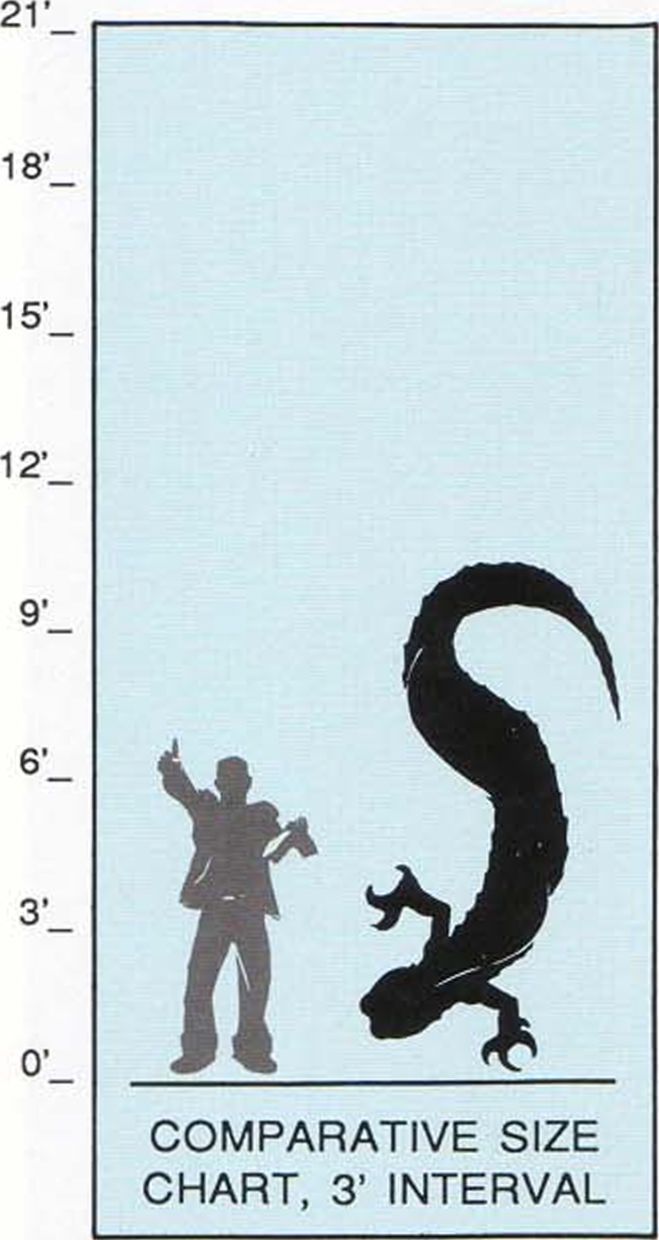
“I have stumbled by cave riddled mountains That rise barren and bleak from the plain, I have drunk of the frog-foetid fountains That ooze down to the marsh and the main;
And in hot cursed tarns I have seen things I care not to
gaze on again.”
— H.P. Lovecraft.
Voonith
A Voonith is an amphibious carnivore, of overall color a blanched pink, yellow, or green, marred by grayish pustules. Its head is salamander-like, with bulging pale eyes and long, lipless jaws. The webbed paws are armed with stout claws for burrowing and clutching. The body ends in a long blunt tail, ridged and finned, without trace of hind limbs. The hide is tough enough to turn a blade. Grayish cysts spotting the body are full of an alkaloid poison, rendering the Voonith’s flesh unpalatable and dangerous to eat. This cunning predator has no natural enemies (Larkhan, 1987).
A Voonith primarily breathes air, though some oxygen is taken in through the skin. When inactive or aestivating, epidermal respiration is sufficient, and the creature can remain underwater for weeks or months at a time. When active, however, the Voonith must surface every hour or two to breathe.
This animal probably derives from caecilians, as indicated by burrowing habits and physical structure.
Habitat: the Voonith lives in swamps and marshes. An occasional adult may find its way into a lake or stream, but can breed only in stagnant water.
Distribution: throughout central Dreamlands.
Life and Habits: this beast is a notorious hazard of the swamps and marshes of the Dreamlands. Voracious and fearless, some Vooniths
Architecture
The ambitious Voonith scoops out an elaborate under-bank shelter, gradually adding closets to hold scavenged booty - this
cut-away drawing shows caches
dig twisty mazes of water-filled burrows just beneath the ground surface, attacking by erupting from burrow or pond to grab and drag down prey. In an attack, the Voonith not only bites, but uses its worm-like hindbody and powerful musculature to encircle and crush the victim. Frequently the attack concludes when the
victim drowns.
The Voonith reproduces like other amphibians, gluing clusters of jellied eggs to underwater stumps or rocks. Tadpoles are large and covered with bitter slime. Maturing, their feathery gills wither
of human skulls and of gemstones. At the right: a fawn stands atop a Voonith tunnel.
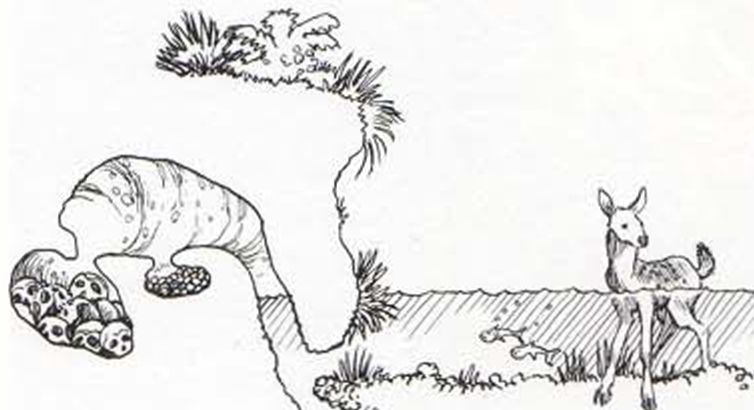
and their legs sprout.
Distinguishing Vooniths —
♦ Fireworms of Parg have no limbs, avoid water, and are covered with horny plates.
-57-—


Hungry Baby
Spontaneously generated, a baby Wamp explodes through the lifeless skull of a predecessor. Wamps abiogenate in random corpses of more than 40-50kg dead weight, including corpses of their own species.
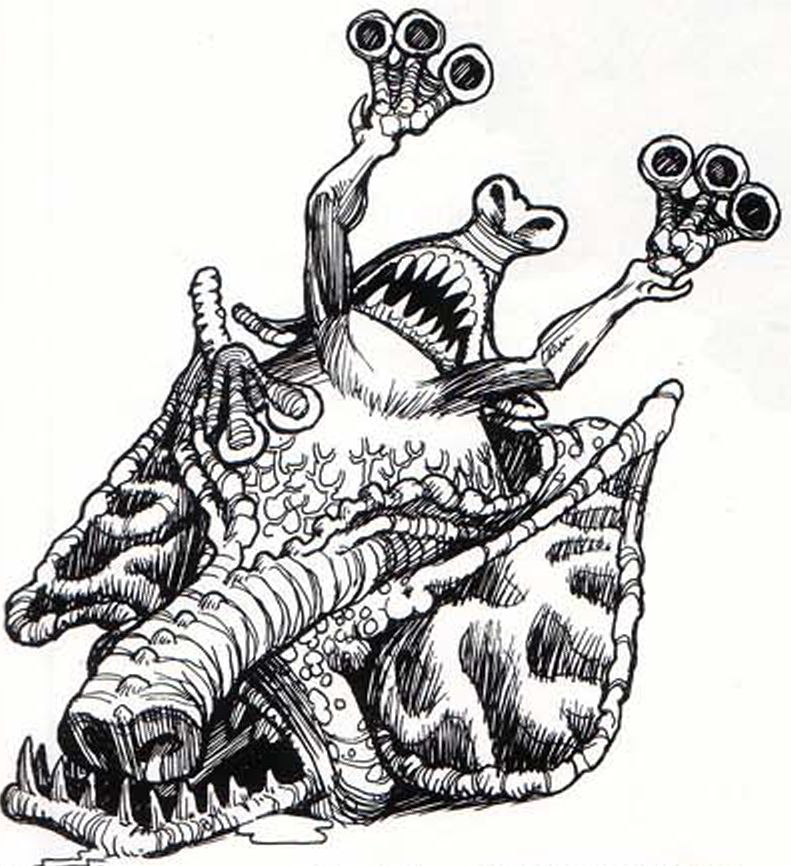
Fig. 25 — Birth of a Wamp.
“Searchers after horror haunt strange, far places. For them are the catacombs of Ptolemais, and the carven mausolea of the nightmare countries. They climb to the moonlit towers of ruined Rhine castles, and falter down black cobwebbed steps beneath the scattered stones of forgotten cities in Asia. The haunted wood and the desolate mountain are their shrines, and they linger around the sinister monoliths on uninhabited islands.”
— H.P. Lovecraft.
Wamp
An obscene scavenger haunting dead cities, the Wamp has a pale egg-shaped body and nine swaying legs. The head is eyeless. It has sharp-edged ears and creased snouts drooping over flabby lips. The feet are webbed and splashed with scarlet.
This contaminated monstrosity carries and spreads disease. Its bite is notorious for injecting odious infections; anyone injured, especially bitten, by a Wamp should seek competent medical attention immediately. Untended wounds always fester and often teem with worms. Diseases known to be carried by Wamps include black fever, gangrene, leprosy, plague, and rabies.
Though blind, this creature hunts actively and aggressively. Its sense of hearing and scent are phenomenal, but there may be more to it than that. Atal (1983) states that the species possesses an additional sense, termed the ’hunger sense’, with which the Wamp perceives and finds living animate beings.
Habitat: ruins, graveyards, any site of corruption. Though it cannot breathe water, it prefers soggy surroundings, especially polluted water, and seems naturally attracted to dumps, sewers, and abandoned wells.
Distribution: throughout the Dreamlands. Wamp ubiquity apparently deters Ghouls from the inner Dreamlands (Dannseys, 1968); the Ghouls may not relish competing for putrid forage.
Life and Habits: dead cities spawn this species, evidently by spontaneous generation from the mummified corpses of largish creatures. Though intelligent, the Wamp is drawn to foulness and decay, and feeds only on carrion and unspeakable waste. If a Wamp slays a human or other prey, it does not eat immediately, but stores (often underwater) the body for several weeks until the flesh rots enough to suit the monster’s tastes.
These solitary hunters band together near each solstice and equinox for vile pseudo-religious ceremonies.
Distinguishing Wamps —
♦ Leng Spiders are multi-legged, but are purplish. Their heads are spider-like, completely different from that of Wamps.
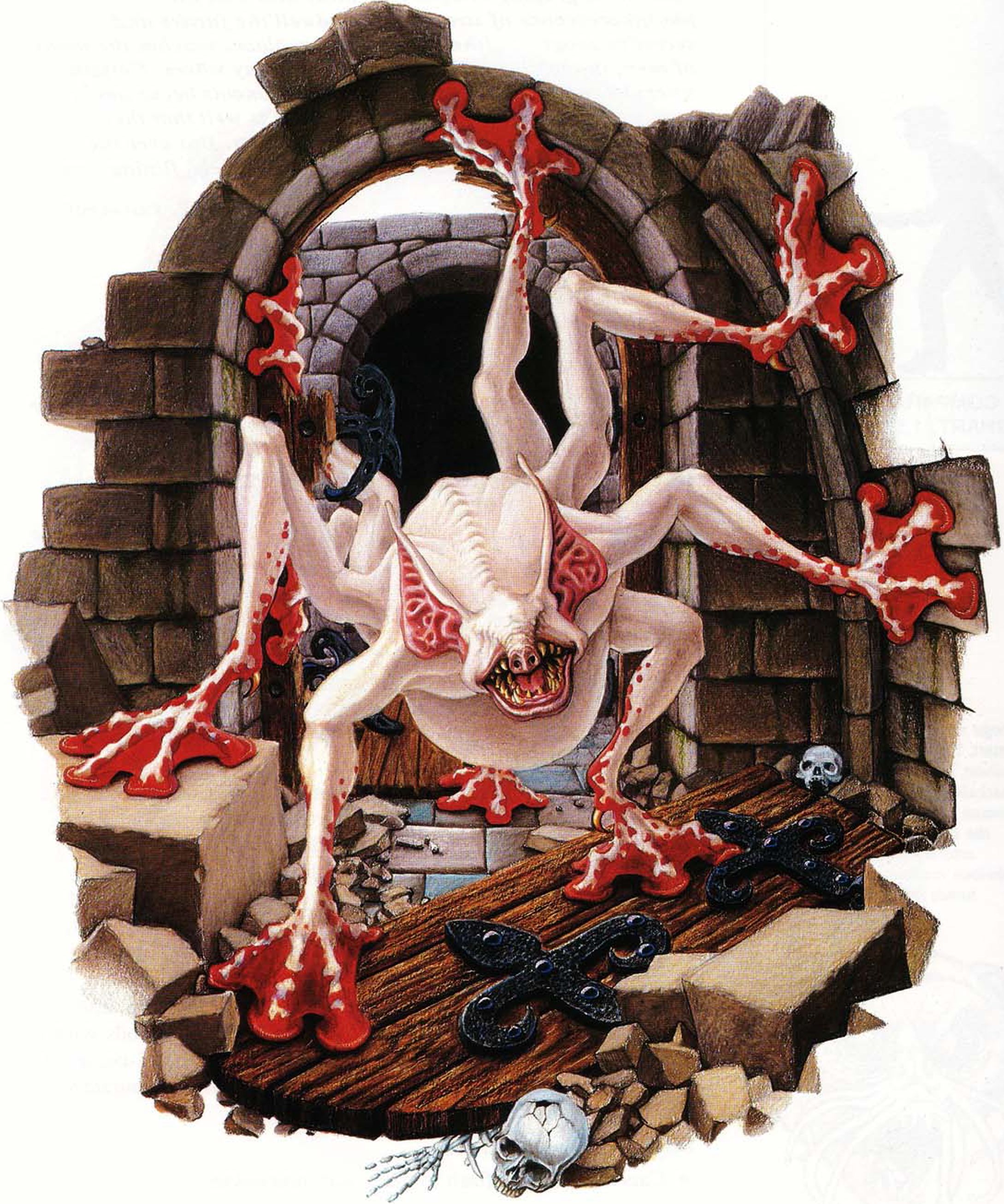
[Ferrari
J ©198S
10.5’
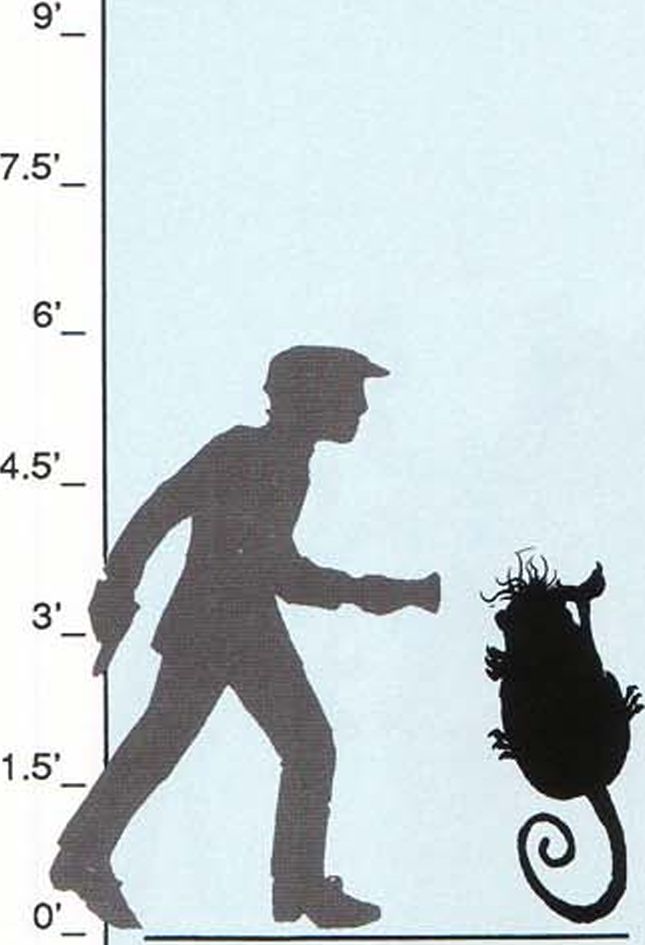
COMPARATIVE SIZE CHART, 1.5' INTERVAL
Angry Zoog
Zoogs not only are devious and smart, but vicious. Working in unison, the mouth tentacles are remarkably strong and can grip a human arm, for instance, while the fangs sever tendons and arteries. Zoog attacks, for obvious reasons, are usually in bands of a dozen or more.

“In the tunnels of that twisted wood, whose low prodigious oaks twine groping boughs and shine dim with the phosphorescence of strange fungi, dwell the furtive and secretive zoogs . . . [their] wood at two places touches the lands of men, though it would be disastrous to say where. Certain unexplained rumours, events, and vanishments occur among men where the zoogs have access, and it is well that they cannot travel far outside the world of dream. But over the nearer parts of the dream-world they pass freely, flitting small and brown and unseen . . . .”
— H.P. Lovecraft.
Zoog
A Zoog is a small, brown, rather rodent-like animal. Small tentacles twirl from its snout, concealing a mouthful of sharp teeth. It is an excellent climber and a skilled burrower. The Zoog is intelligent and cunning, perfectly capable of making and using utensils and weapons at need, though rarely actually doing so.
Habitat: deep woods, especially those in climates favoring heavy fungus growths.
Distribution: the Enchanted Wood, right in the middle of the Dreamlands. Wasling (1964) reports that two other colonies exist, one in the frigid taiga east of Leng, and another near Sarrub. No doubt there are more.
Life and Habits: the creature usually lives in a burrow. Some colonies drill tunnels through old trees till passages honeycomb the trunks. A Zoog’s primary food is fungi, but it finds meat toothsome. Despite small individual size, packs of Zoogs have been known to kill and eat people.
The Zoog is as intelligent as a human, and its woodland habitat is (in a manner) civilized.These creatures can be negotiated with so long as the investigator is careful and diplomatic. Zoogs have a fluttering language which humans can learn. Every Zoog greatly prizes certain objects; if an investigator can offer one or more of these, a treaty and a friendly working relationship should follow. Objects of proven worth to Zoogs include hydra teeth, tales of astounding dreams, and tools from Malebolge (Carter, 1924).
A Zoog treats only with an individual. If, for instance, after signing a treaty, a dreamer returned to the Enchanted Woods with a friend, no Zoog must necessarily respect the friend’s well-being. On the other hand, a contract with one Zoog is (usually) a contract with all Zoogs.
Distinguishing Zoogs —
-
♦ Cats from Saturn flash in many different colors;
-
♦ Haemophores have no fur, and no tails.


5 Creatures Identified

Ghoul
“I saw outlined against some phosphorescence of the nether world a horde of silent toiling things which only insanity — or worse — could create. Their outlines were human, semi-human, fractionally human, and not human at all — the horde was grotesquely heterogenous.”
— H.P. Lovecraft.
Ghast, Ghoul, Moon-Beast, Nightgaunt, Shantak
No text on Dreamlands life can ignore these five creatures. However, since they have been discussed at length in S. Petersen’s Field Guide to Cthulhu Monsters, brief mention is made here.
Ghast: a large floundering whitish thing with a black-furred back and traces of human ancestry in its noseless face. It moves by leaping on long hind legs. It cannot survive in sunlight. Ghasts inhabit the Abyss, especially the Vaults of Zin. They have a crude language, but are only semi-intelligent. ♦ Beings of lb are greenish, do not leap, and are smooth; Gugs are larger and hoofless; Men of Leng have horns, noses, and foreheads, and are more human-like.
Ghoul: roughly bipedal, with a slouched, vaguely canine aspect, rubbery hide, half-hooved feet, and scaly claws. The species lives in the Abyss and feeds in the waking world, exiting the Dreamlands through secret tunnels to enter human graveyards and other feeding grounds. ♦ Beings of lb are greenish with soft moist skin and amphibian-like faces; Men of Leng have horns and human-like faces; Serpent People are tailed and scaled.
Moon-Beast: a toad-like grayish oily being which can alter its body
shape. Its sole visible sense organ is a cluster of vibrating pink tentacles on its snout. It is intelligent and ruthless. The species lives
on the Moon, trading with many different planets. ♦ Cloudbeasts are much larger, float through the air, and have foggy texture; Gnorri have eyes and other sense organs, and can swim; Zoogs are furry and much smaller.
Nightgaunt: a faceless humanoid being with bat-like wings, horns, barbed tail, and oil black skin. Mindless flocks of them nest in barren remote mountains such as the Peaks of Thok. Encountering an intruder, a Nightgaunt seizes and carries off the struggling victim, tickling him or her into submission. Eventually the hapless captive is abandoned in some extremely dangerous place, as convenient for the Nightgaunt. ♦ Nightgaunt facelessness and large webbed wings are unmistakable.
Shantak: a huge winged monster with scales, a long neck and tail, and a slightly horse-like head. The species is common on the Plateau of Leng and northwards. With some difficulty for the trainer, the creature can be domesticated, and is useful as a steed and watch-beast. ♦ Butterfly-Dragons are much smaller and have insectoid limbs.
Fig. 27 — Five Dreamlands creatures, relative proportions.
-63-

RECOMMENDED READING from Arkham House Publishers — — . 1964. At the Mountains of Madness and Other Novels. Corrected 5th printing. — . 1965. Dagon and Other Macabre Tales. Corrected 5th printing.
from Chaosium Inc. —
Petersen, Sandy. 1986. Call of Cthulhu: Fantasy Roleplaying in the Worlds of H. P. Lovecraft. 3rd edition. Lynn Willis, ed. Various authors additional material.
supplements to the game:
Barton, W.A. 1988. Cthulhu by Gaslight. 2nd edition. S. Petersen and L. Willis, eds.
Costello, M.J., with Willis, L. 1985. Alone Against the Dark.
DiTillio, L, with Willis, L. 1984. Masks of Nyarlathotep.
Berber, K. 1984. The Fungi From Yuggoth. S. Petersen, ed.
—. 1984. Trail ofTsathogghua [sic], S. Petersen, ed.
—. 1986. Spawn of Azathoth. L. Willis and S. Petersen, eds.
Petersen, S., and Kahn, S., eds. 1986. Terror From the Stars.
Petersen, S., and Willis, L. Miskatonic U. Graduate Kit.
Petersen, S.; Robson, K. L.; Berber, K.; and others. 1988. H.P. Lovecraft's Dreamlands. 2nd edition. L. Willis, ed.
Petersen, S., and Ferrari, M. 1988. Petersen's Field Guide to Creatures of the Dreamlands. L. Willis, ed.
Petersen, S., and Sullivan, T. 1988. Petersen’s Field Guide to Cthulhu Monsters. L. Willis, ed.
Petersen, S., and Willis, L., eds. 1982. Shadows of Yog-Sothoth.
—, eds. 1983. The Asylum and Other Tales.
—, eds. 1985. Fragments of Fear.
—, eds. 1987. Terror Australis.
—, eds. 1988. Cthulhu Now.
Rahman, G. 1985. Alone Against the Wendigo. L. Willis, ed.
Sullivan, T., and Willis, L. 1988. Cthulhu Covers. Reproductions of tome bindings. Willis, L., and Petersen, S. 1987.
Miskatonic U. Graduate Kit. [the school catalog completely summarizes current hyperdimensional scholarship.]
BIBLIOGRAPHY
Atal the Priest. 1983. Memory Or Dream. New York: Alfred A. Knopf.
Barzai the Wise. 1572. Alere Flammas: Warnings Upon Mankind. 1988 trans, by R. Blake. Philadelphia: Golden Goblin Press.
Carter, Randolph. 1924. “Phraseology and Intonation in the Tongue of the Zoogs,” Medieval Metaphysics Journal, 17:88-104.
—. 1929, 1964. “The Dream-Quest of Unknown Kadath,” in At the Mountains of Madness. Narrated as fiction. Sauk City, Wisconsin: Arkham Bouse Publishers.
-
— . 1939. Memoirs. New York: Random Bouse.
Choirs, Anne Scoa. 1972. “Psychoreactive Properties of Three Dreamlands Aerosols,” Proceedings of the International Metaphysics Society 30:25-42.
Dannseys, Peter. 1978. The Life of the Haemophore. Arkham, Massachusetts: Miskatonic University Press.
-
— . 1986a. “Letter Remembering Barton and Doherty,” Proceedings of the International Metaphysics Society. 44:3-4.
-
— . 1986b. “The Bunter Which Will Not Bide,” Dreamlands Studies 11:181-204.
-
— . 1988. Elegant Symmetry: Inversion and Reversion in Dark Dimension Demi-Life. New York: Boughton Mifflin.
-
— , and Marsh, S. Robert. 1972.
’ ’Neuroendocrine Structures and Functions in Select ’Lotogs,’ ” Abstracta Bestialis 78:101-131.
Fallworth, E.C. 1939. “Mercantilism in Dylath-Leen,” Symposia Hypermeta-physica, 37:18-26.
-
— . 1944. “Tsathogguan Periodic Metamorphosis and the Hemimetabo-loids,” Symposia Hypermetaphysica, 42:324-379.
Gillman, W. Duin. 1979. “Minion-Induced Fibrillation in Bumans: Case Studies," Annals of the Innsmouth Society 119:192-221.
-
— . 1982. “Identities in Ibite Dentate, Embolifonn, Globose, and Fastigial Nuclei, and in Vestibular Structure,” Publications of the Arkham Biophysical Institute, 35:21-59.
Bike, Berbert. 1981. Lamp-eft Anatomy and Physiology. 2nd edition. Ann Arbor: University of Michigan Press.
Isinwyll, L.N. 1975. Yog-Sothoth in the Eastern Pacific. Berkeley: University of California Press.
—. 1987. “Larvae Log-Phase Modulations,” Annals of the Innsmouth Society, 120:34-37.
—. 1988. “Abhoth: Its Bypothetical Parameters,” Proceedings of the International Metaphysics Society 46:412-444.
—. 1989. “The Awesome Bnazie,” 75 Tours for the Casual Dreamer (I. Wilb-ham, ed). New York: Bantam Books.
Larkhan, Eric K. 1982. “F. Saturnius and Lunar Territorial Propitiations,” Abstracta Bestialis 88:18-82 (see supplementary letter, 88:343).
—-. 1987. “The Role of the Voonith in Marshland Ecosystems,” Dreamlands Studies 12:244-254.
Lochert, Robb. 1983. “Capturing the So-Called ’London Entity’ (with Interview),” Proceedings of the International Metaphysics Society 41:85-92.
Marik, Rafer R. 1987. “Behavior and Diet of pseudoRhinogradentia,” Dreamlands Studies 12:235-243.
—. 1989. “A Survey of Preternatural Dangers in the Dreamlands,” Proceedings of the International Metaphysics Society 47:18-104. With tables.
Marsh, S. Robert. 1976. “Extension and Resorption in Nubes raptus (Robson),” Abstracta Bestialis 82:39-78.
Meeb, Ronno. 1979. The Natural History of the Leng Spider. Arkham: Miskatonic University Press.
—. 1986. Quantitative Studies in Dreamlands Motor Forms. Arkham: Miskatonic University Press.
—. 1988. “Caged Magahs Lead to a Despicable Trade,” Proceedings of the International Metaphysics Society, 46:390-397.
Mustoll, Ivan. 1988. “The Buopoth Proboscis,” Dreamlands Studies 13:140-167.
Ratsegg, F. Ford. 1969. Wandering the Plains of Sydathria. Berkeley, California: Medicine Bag Press.
Smith, C.A. 1931a. The Dream of the Spider, and the Awakening. Philadelphia: Golden Goblin Press.
—. 1931b. “Saturnian Relation and Status,” Sons of Dunwich Quarterly 107:45-63.
—. 1932. “Examining Tomes of Knowledge,” The Occult Librarian, March: 23-29.
—. 1934. “The Spider, in Four Ancient Texts,” The Occult Librarian, June: 39-52.
StUmpke, Harald. 1964. Bau und Leden der Rhinogradentia. Hamburg: Mutwillig Verlag.
Treer, Tamlan. 1984. A Preternatural Bestiary. 6 vols. New York: Harper & Row.
Wasling, Noah. 1964. “Zoog Colonies around the Cerenarian Sea,” Annals of the Innsmouth Society. 97:157-191.
—. 1971. “A Proof of Parallel Neurohe-mal Organs in the Leng Spider.” Unpublished paper presented during the 1971 School of Medieval Metaphysics conventicle, Miskatonic University.
Webber, Karl. 1973. The Role of Acetylcholinesterase in Lamp-eft Body Economy. San Francisco: W.H. Freeman.
Wydatem, Zoranski. 1990. Categorical Imperatives and Primordiality: Logical Proof in Emergence Myth. Arkham: Miskatonic University Press.
Your dreams are valuable! The newly reorganized Windthrope Institute for Dream Research offers significant reward for dreamers granted passage by Nasht and Kaman-Thah. Write the Windthrope Institute, Department of Acquisitions, Clau-son CO 81639.
-